
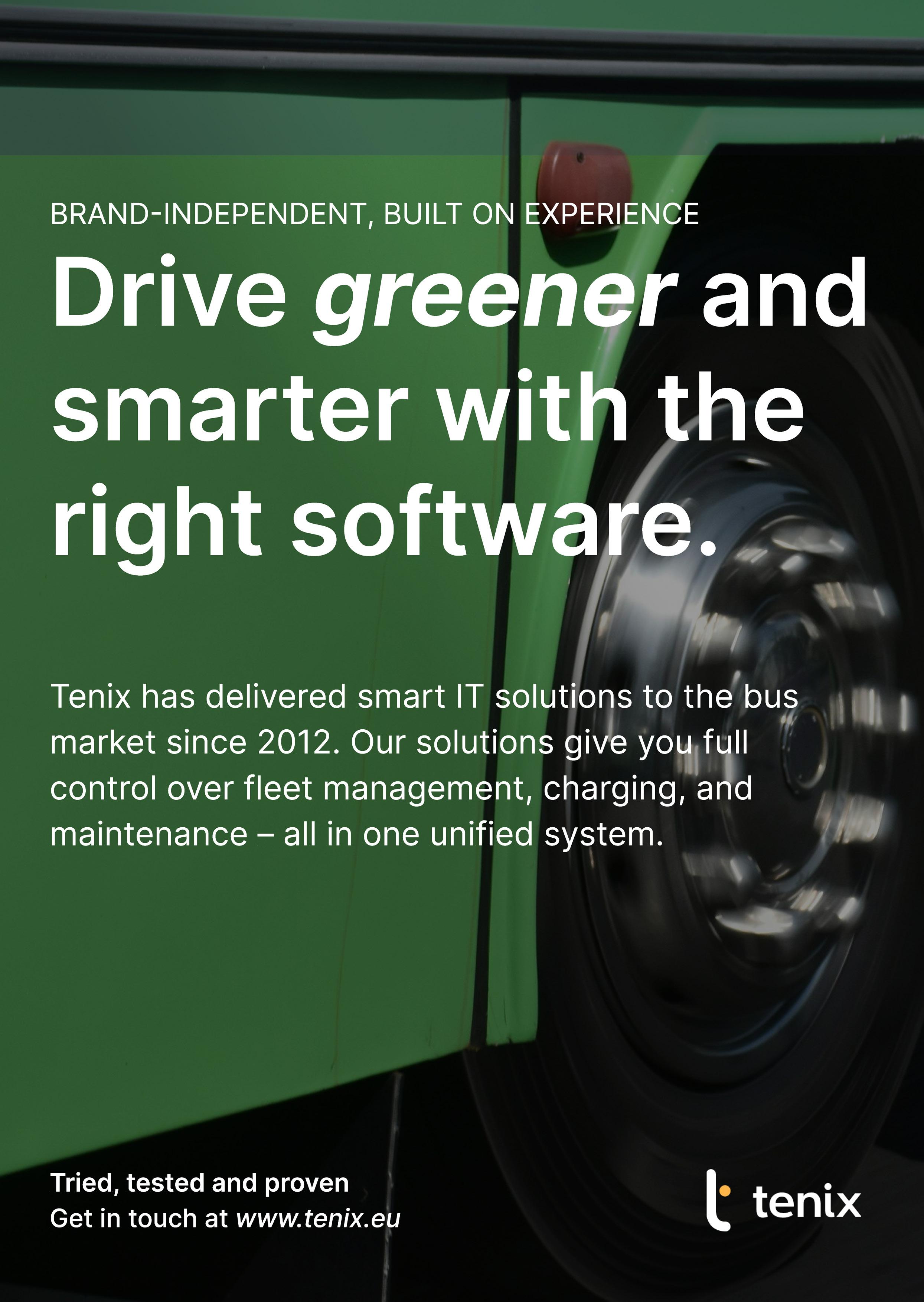



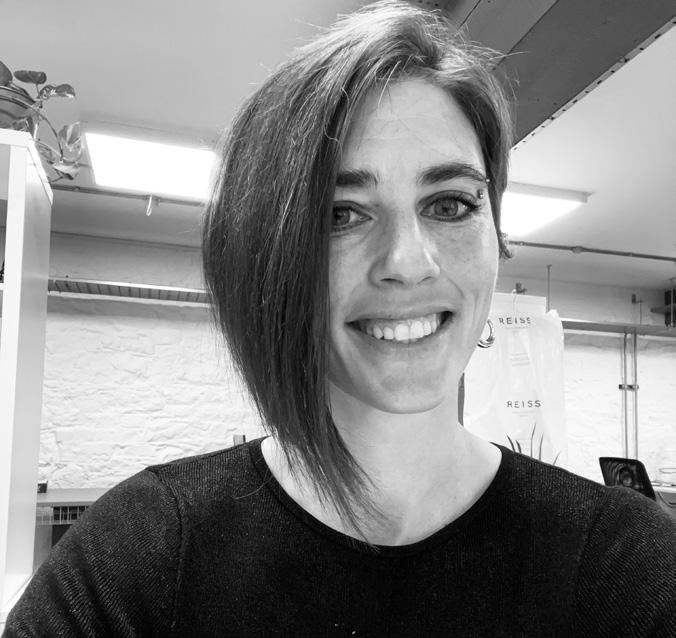
Dear Readers,
Taking place at the NEC in Birmingham (UK), the Euro Bus Expo 2024 event is one of the key events for the bus and coach sector in the United Kingdom so we are taking a special look at this event (p.10) for our second issue of 2024.
At InnoTrans 2024, the International Bus Forum took place with important discussions about the state of the industry, set within the wider context of technological advancements such as artificial intelligence, decarbonisation efforts, the move towards electrification of vehicle fleets and changes in travel patterns. In ‘Where Do Buses Stop with New Tech?’ (p.6), Tiana May explores whether the industry can keep pace with the rollout of new technologies to deliver efficient and desirable services.
In our section on bus design & interiors, our suppliers highlight solutions such as passenger lifts, push buttons and seating – all important for the passenger experience.
Electric vehicles also mean new challenges for maintenance and access. For example, Columbus McKinnon (p.38) explains that whereas diesel buses require almost no work in the bus roof, electric buses require much more work there because heavy electrical and other high-maintenance components such as battery packs are located there.
However, with the increasing introduction of electric vehicles, it is now possible to look to operators who have done so successfully. In ‘Driving the UK’s Decarbonisation Through Electrification of Public Transport’ (p.42), Tenix says the UK can learn valuable lessons from the Nordic region, which has pioneered electric bus operations in diverse weather conditions for many years.
We hope you enjoy this issue. As always, we welcome your feedback and insights, which you can send to the Editorial team at editorial@a2bglobalmedia.com.
If you would like our bus news straight to your inbox, make sure you’re subscribed to us here. If you want to be featured on our site or in our e-magazine, please get in touch with Andrew Lush at al@a2bglobalmedia.com or call +44 7432 725001.

Josephine Cordero Sapién, editor-in-chief
ANDREW LUSH Director al@a2bglobalmedia.com
JOSEPHINE CORDERO SAPIÉN Editor-in-chief jcs@a2bglobalmedia.com
NICOLA BROWN Head of Sales nb@a2bglobalmedia.com
ZOE GRIFFEY Head of Design zg@a2bglobalmedia.com
TIANA MAY Principal Journalist tm@a2bglobalmedia.com
a2b Global Media Ltd
The Generator Hub, The Gallery Kings Wharf The Quay, Exeter EX2 4AN
Office: +44 (0)1392 580002 Mobile: +44 (0)7432 725001
Email: info@a2bglobalmedia.com Website: bus-news.com
To subscribe to our newsletter, visit bus-news.com/subscribe
COVER: © a2b Global Media Ltd


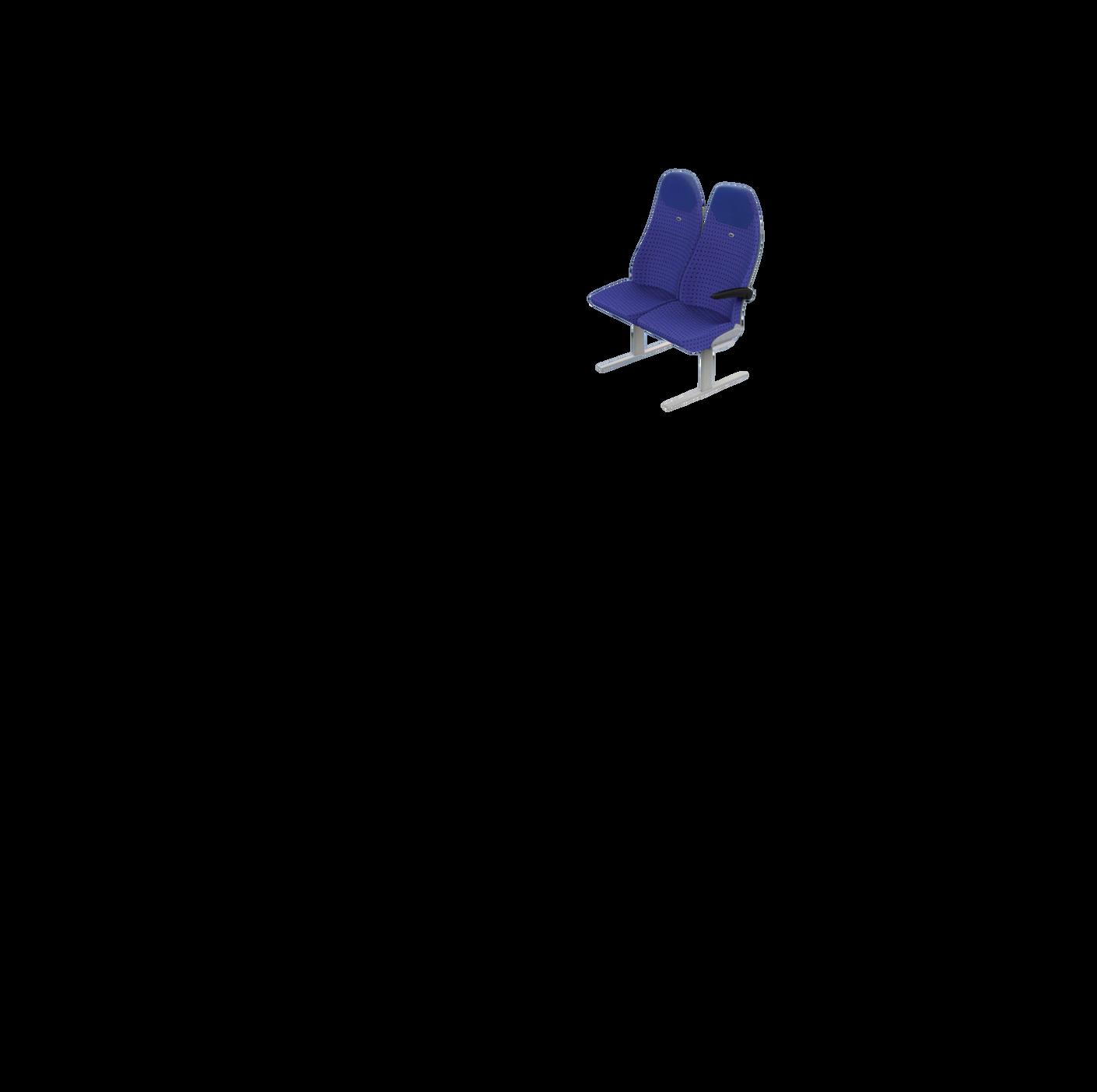
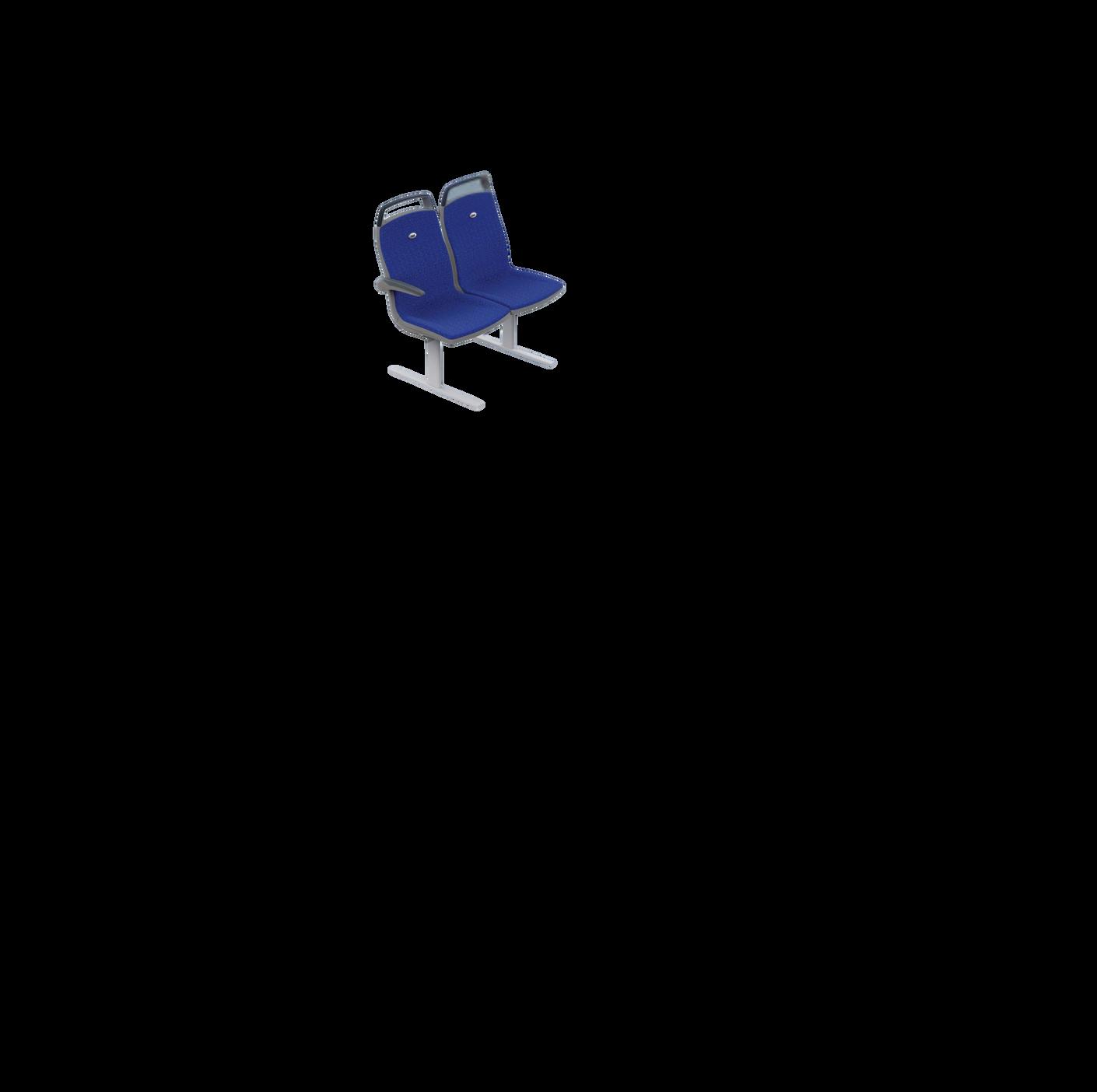


Our journalist Tiana May looks at the challenges and opportunities facing the bus industry as it integrates new technologies, highlighted during InnoTrans 2024’s International Bus Forum.
Directory
Bus Design & Interiors – p.13
Maintenance & Servicing – p.31
Electrification & Power – p.41
Digital Solutions – p.51
Taking place at the Birmingham NEC next month, we take a look at what’s in store at this year’s Euro Bus Expo.
Our top picks for suppliers attending Euro Bus Expo and what solutions they offer to the bus industry..
A look at what key bus events are taking place between November 2024 and March 2025.
By Tiana May, Principal Journalist

During InnoTrans 2024, the International Bus Forum addressed the current developments and challenges faced by the bus industry. Notably, the convention explored whether the industry can keep pace with the rollout of new technologies to deliver efficient and desirable services.
InnoTrans 2024 took place in Berlin from 24–27 September 2024. In line with global trends and developments, this year's show included a particular focus on the role of artificial intelligence (AI) in making transport more efficient, sustainable and customerfriendly.
Despite this focus, during the International Bus Forum, Johannes Wieczorek, Permanent Secretary for Urban Mobility and Transport Berlin, stressed the importance of functionality and simplicity over implementing a plethora of new innovations. This sentiment was echoed by Dr Rolf Erfurt, COO of Berliner Verkehrsbetriebe (BVG), who emphasised the
need to "provide stability prior to performing open heart surgery".
Notably, the bus industry is already undergoing a major transition through the adoption of zero-emission vehicles. Although Erfurt noted that BVG achieved the same stability in vehicle availability for electric and diesel buses, he also acknowledged that the industry was still learning to combat associated challenges, such as fire safety for electric buses. Meanwhile, operators are balancing this transition with the need to improve services for passengers who desire frequent and reliable services.
Consequently, applicable innovation is arguably key to effectively addressing these needs and providing solutions for new roadblocks and longstanding issues alike. For example, Christoph Ziegenmeyer, VP Communications and Public Affairs at MOIA argued
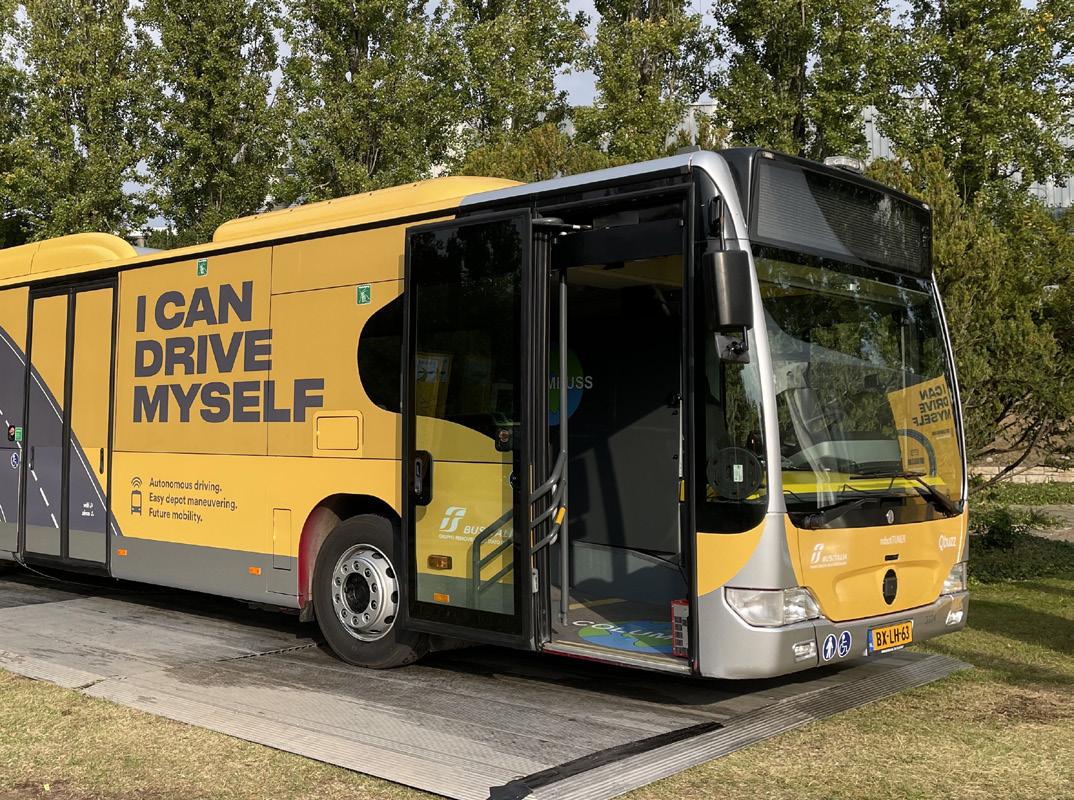
that customers needed reliable, real-time information to feel in control of their journey. In response to this demand, digital solutions can provide key tools for collecting, processing and communicating the required data.
Joris D'Incà, Partner in Oliver Wyman's Transportation practice added: "Innovation will become more important because there are big challenges in the future that can only be solved by technological innovations."
However, to successfully realise the benefits of new innovations, it is imperative for developments to align with relevant industry challenges in a way that is useful. What's more, they also need to be delivered at the right time to provide a scalable solution. Otherwise, new ideas could clash with, rather than support, the industry's current focus and roadmap.
Johannes Wieczorek, Permanent Secretary for Urban Mobility and Transport Berlin asserted: "Innovations are great.Innovations are fantastic.But sometimes they don't come at the right time.Sometimes they don't come in the right quality.Berlin needs robust innovations,things that are worked out,that can be implemented,that users of public transport here in Berlin accept."
Innovations that do contribute to stability often leverage simple but effective ideas. For example, Wieczorek praised the Lightgate solution used on the S-Bahn, which shows waiting rail passengers how full individual carriages on trains are. By providing
such information, this technology can help enhance the passenger experience without altering standard operations.
What's more, to ensure innovation is not overcomplicated, Erfurt advocated for replicating successful implementations, rather than networks trying to reinvent their own solutions. Alongside the benefit of implementing proven solutions, Erfurt acknowledged that this approach could open up the possibility of joint tenders with other transport operations, as well as provide consistency for passengers across networks.
When initially trialling the technologies, Thomas Wolf, Chief Operating Officer at Siemens Mobility's Hacon, highlighted the advantages of using specific locations as model cities. This allows resources and finances to be concentrated on perfecting a rollout before replicating best practices elsewhere.
This approach is particularly important for breakthrough technologies like autonomous driving, which require extensive research, testing and development. Although such innovations are far from simple to implement, they could play an effective role in combating industry challenges, such as driver shortages. It is therefore crucial to ensure investment in such technology is smart and collaborative.
Ease of use is a key criterion for a successful public transport network, and passenger acceptance and understanding of new technologies are therefore a necessary consideration, especially as the industry continues to follow the trend of digitalisation.
Christoph Ziegenmeyer, VP of Communications and Public Affairs at MOIA, highlighted that this challenge was particularly relevant in Europe, where operators must integrate new technologies with existing systems. In contrast, building entirely new networks allows operators to introduce the latest technologies as the standard from the outset, making adoption smoother for customers.
This applies to technologies such as tap-on and tap-off contactless payments on buses. In Germany, Ziegenmeyer noted that around 60% of payments were still made with cash, which is largely attributed
to cultural factors and a high concern for data privacy. When rolling out new technologies, he therefore stressed that it was important to address these concerns and communicate effectively to reassure customers that their data was protected.
Through this approach, BVG has successfully eradicated cash payments on buses, largely influenced by adaptations during the pandemic. Alongside streamlining the boarding process for passengers, this change has saved the operator on costs and staffing resources that were previously used to service and clean onboard cash machines. These savings can now be reinvested into improving the network, reinforcing the advantages of embracing smart technologies.
In addition to customer-facing technologies, modern innovations are also transforming internal operations, such as depot management and scheduling.
For example, Bastian Dittbrenner, Managing Director at IVU Traffic Technologies explained how integrated IT systems could streamline resource planning and control centre operations. These systems not only ease the burden on human resources, particularly in the face of worker shortages, but they also play a crucial role in the shift to electric fleets by providing the necessary data for efficient charging and scheduling.
Alongside optimising daily operations, software innovations can also drive more informed network planning decisions. During the forum, Georg Polzer, Co-Founder & CEO at Teralytics detailed how analytics could be leveraged to assess how and where people move, thereby establishing the demand for services. For example, a recent study in Bamberg, Germany revealed a high demand for public transport on

Sundays, prompting the operator to offer more services. Similarly, commuting data can reveal from how far people travel into a city, informing the geographical scope of public transport networks.
Polzer also highlighted the growing use of digital twins – virtual models that allow operators to simulate and evaluate the impact of potential decisions, such as adding new stops to a bus route. This ability to visualise outcomes enables operators to make data-driven, strategic choices that can enhance service efficiency and customer satisfaction.
Despite these potential benefits, Dittbrenner acknowledged the need for gradual implementations, so that operators understand the systems and can effectively use the data. This approach allows for smoother integration, helping organisations and their team members adapt to new technologies.
Overall, the discussions at InnoTrans 2024's International Bus Forum highlighted the balance the bus industry must strike as it navigates new technology. While AI-powered tools offer significant opportunities for enhanced efficiency and passenger satisfaction, the forum underlined the importance of smart and gradual implementation.
The bus industry is already undergoing a major transition to electric fleets, while also striving to meet passengers' needs. As operators seek to integrate new innovations, they must ensure the technologies are practical and aligned with existing systems and customer expectations. Simple, proven solutions often provide more immediate stability, while more ambitious technologies, such as autonomous driving, require careful, phased rollouts.
Ultimately, the discussion made clear that while the future of public transport depends on embracing technological advancements, this must be done in a way that supports rather than disrupts current operations. Collaboration between operators, clear communication with customers and a focus on scalability will be key to delivering robust, future-proof solutions that address current challenges and future needs.
Read more from Tiana May, Principal Journalist at www.bus-news.com.
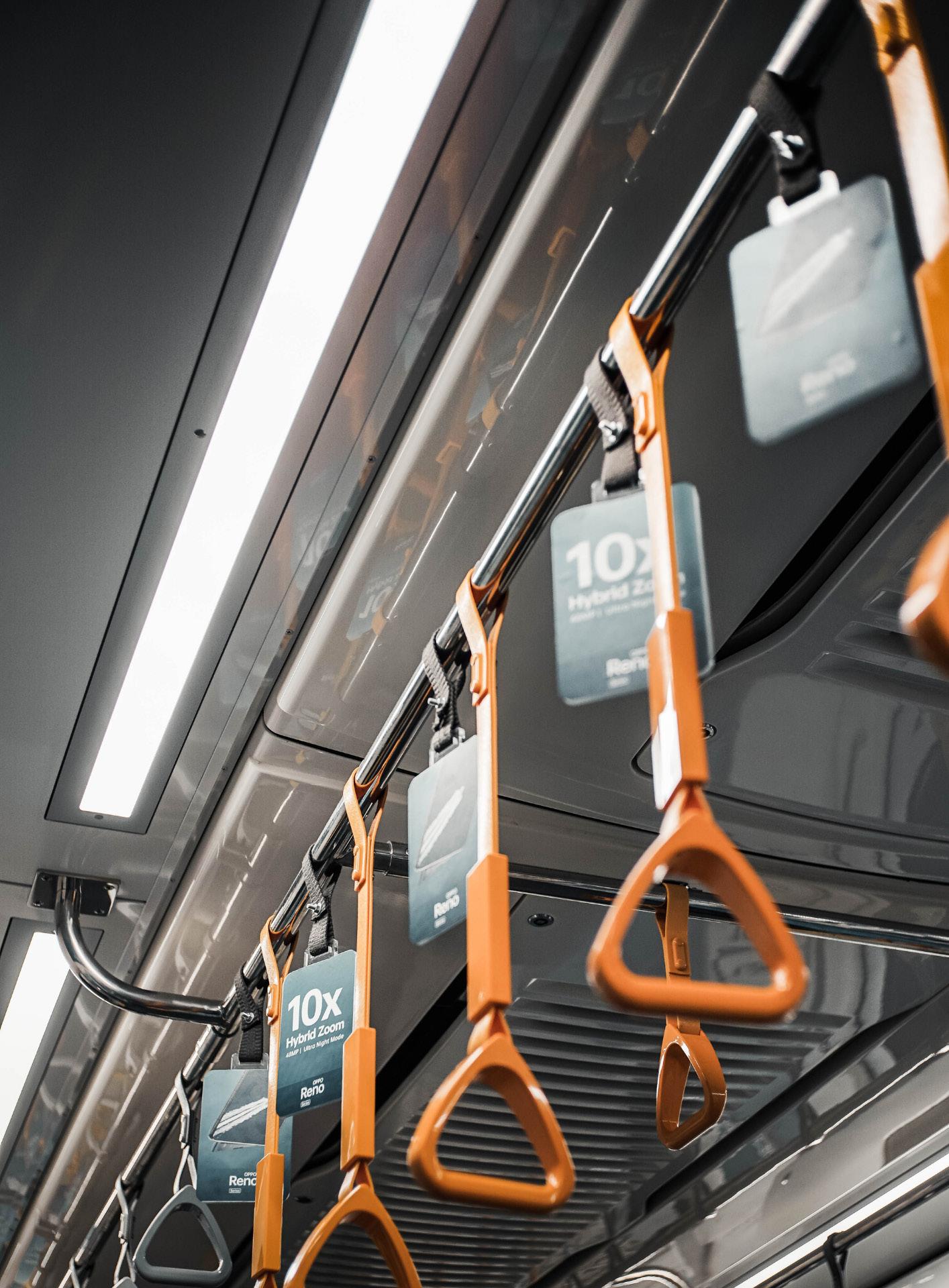

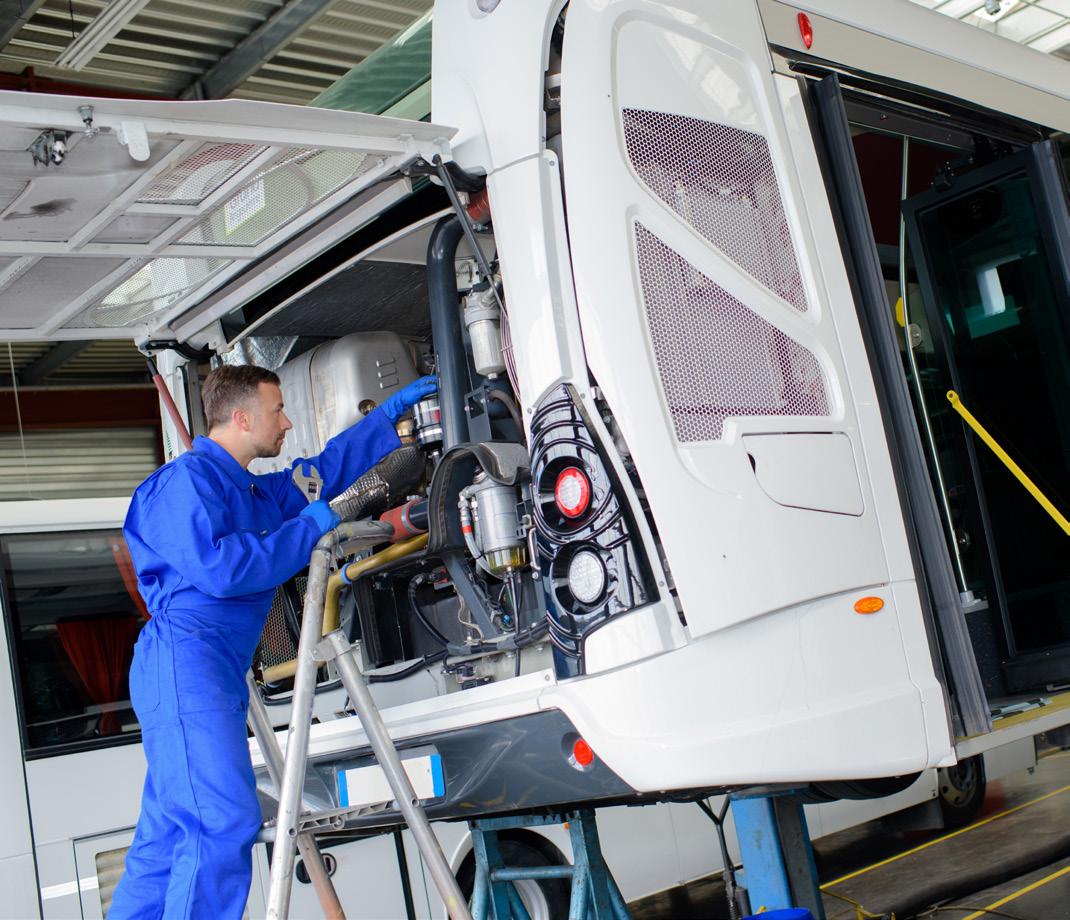
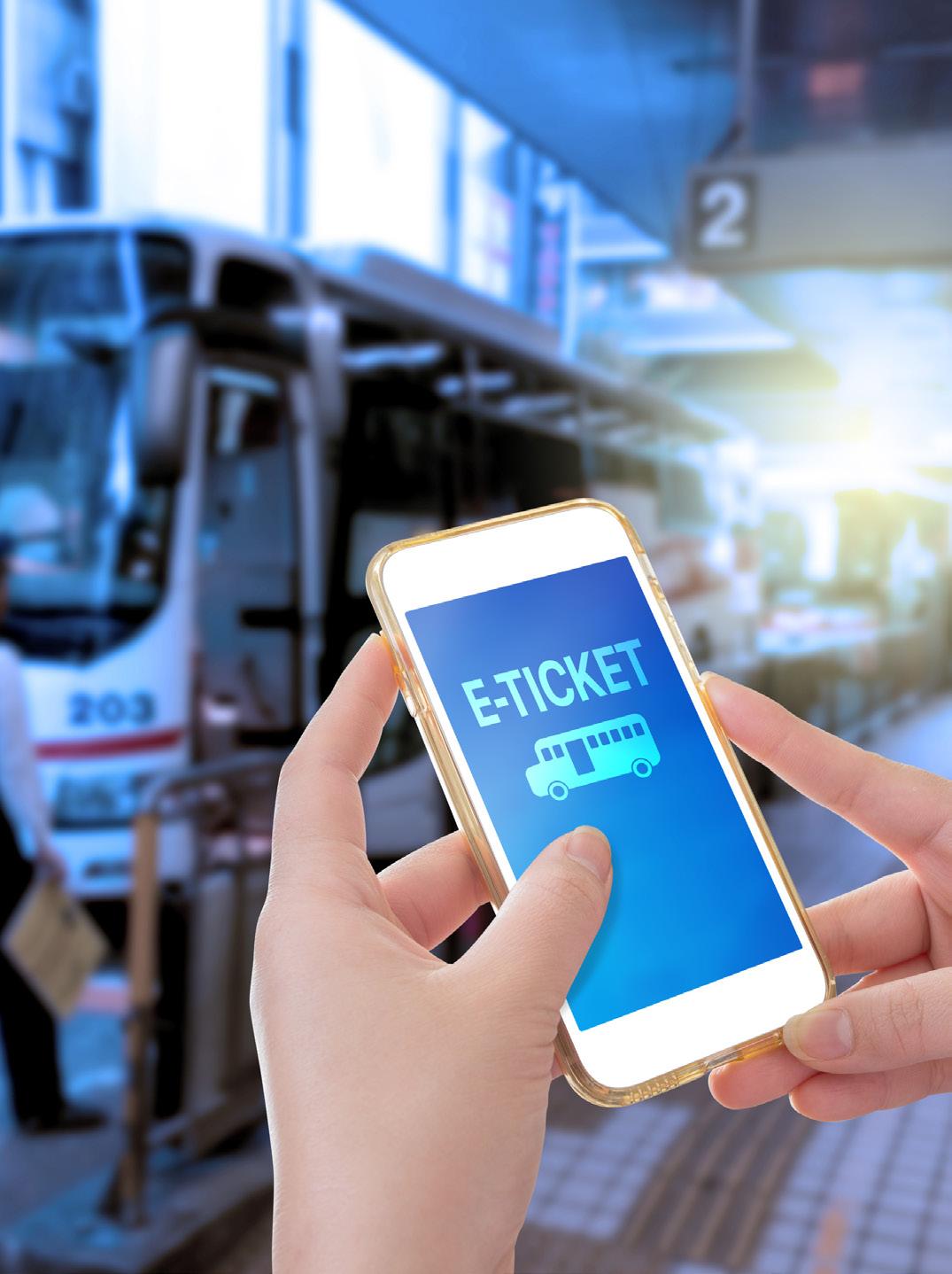

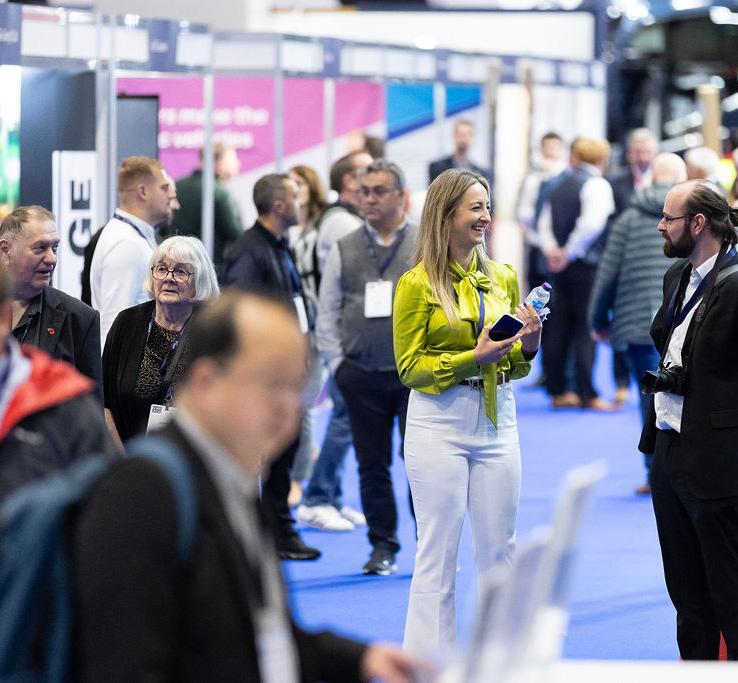
Where: NEC Birmingham, UK
When: 12–14 November 2024
Organiser: DiversifiedCommunications UK Ltd
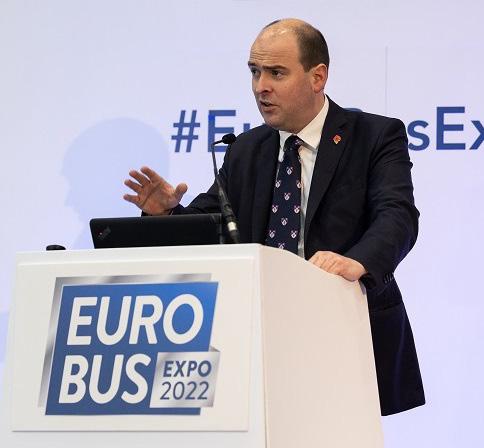
This year, Euro Bus Expo is set to return to the NEC Birmingham to showcase the latest innovations and developments in the bus and coach industry. Taking place every two years, the event brings together manufacturers, suppliers and operators from across Europe to network, explore the latest vehicles and attend three days of informative seminars.
The expo will feature a range of exhibits highlighting the latest products and services, such as zero-emission vehicles and advanced driver assistance systems (ADAS). Key themes throughout the event will focus on the future of public transport, environmental sustainability, the passenger experience and enhanced operational efficiency.
Over 200 exhibitors are expected to participate in this year's iteration of Euro Bus Expo. This will include the display of over 70 vehicles from 23 manufacturers and dealers. Confirmed manufacturers include Alexander Dennis, BYD, Ilesbus, Irizar, Karsan, Mellor, Pelican Bus

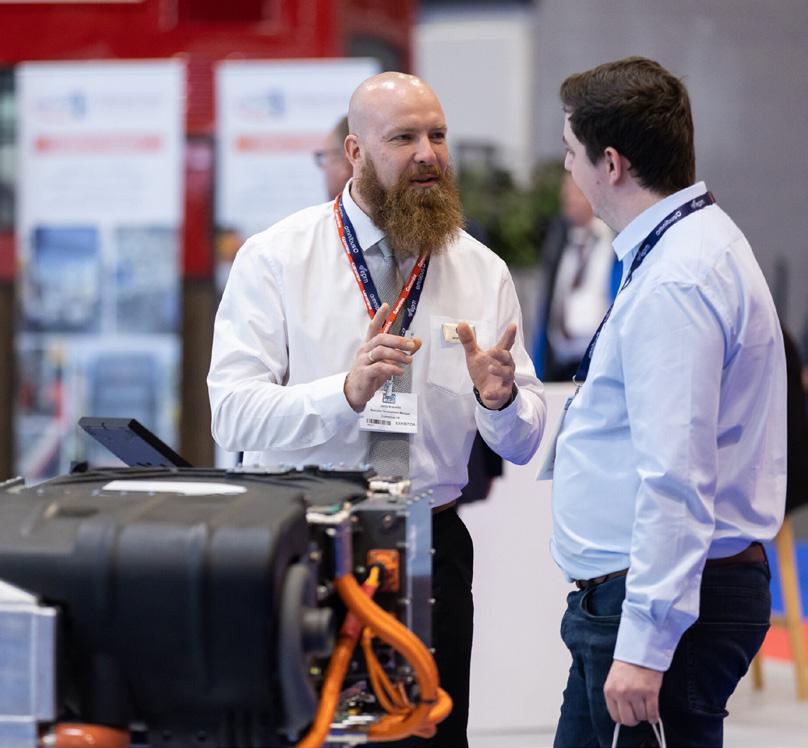
and Coach / Yutong and Scania to name but a few. Vehicles on display will include mini, midi and full-sized buses and coaches.
In addition to complete vehicles, suppliers from across the industry will present products in areas such as bus interiors, traction equipment, lighting, charging infrastructure, telematics, workshop equipment and navigation. The event will thus continue its legacy of helping to launch thousands of new products into the market.
The event’s Innovation Challenge will specifically highlight cutting-edge products and services that aim to transform the future of coach and bus operations. Exhibitors' entries will be presented in the Innovation Challenge Gallery, where attendees can vote for their favourite innovations.
This year, Euro Bus Expo has also launched a new networking platform: Euro Bus Expo Connect. The

platform allows attendees to connect with exhibitors before, during and after the event. Visitors can search for exhibitors, schedule meetings and create personal itineraries with reminders. What’s more, exhibitors can use the platform to profile their offerings, schedule meetings and generate leads. At the event, a new Connect Lounge will provide a quiet space for meetings.
A Masterclass Theatre sponsored by NAVAHO will host a range of discussions on 12 and 14 November with input from industry leaders and policymakers. The sessions will open with a speech entitled: “Preparing the bus for net-zero needs much more than a zero-emission fleet!”, setting the stage with key considerations for the industry.
On 13 November, Euro Bus Expo’s event partner, CPT (Confederation of Passenger Transport UK) will host an Operator Forum that aims to drive innovation and growth in the sector. The forum will address relevant topics such as the role of artificial intelligence, accessibility, the bus workforce and the future of the coach industry.
All sessions are free to attend. The complete schedule can be viewed here.
The Bus-News team will be in attendance at Euro Bus Expo to report on the latest vehicles, technology and discussions in the industry. Stay tuned or subscribe to follow our event coverage.
Click here to find out more about the event.
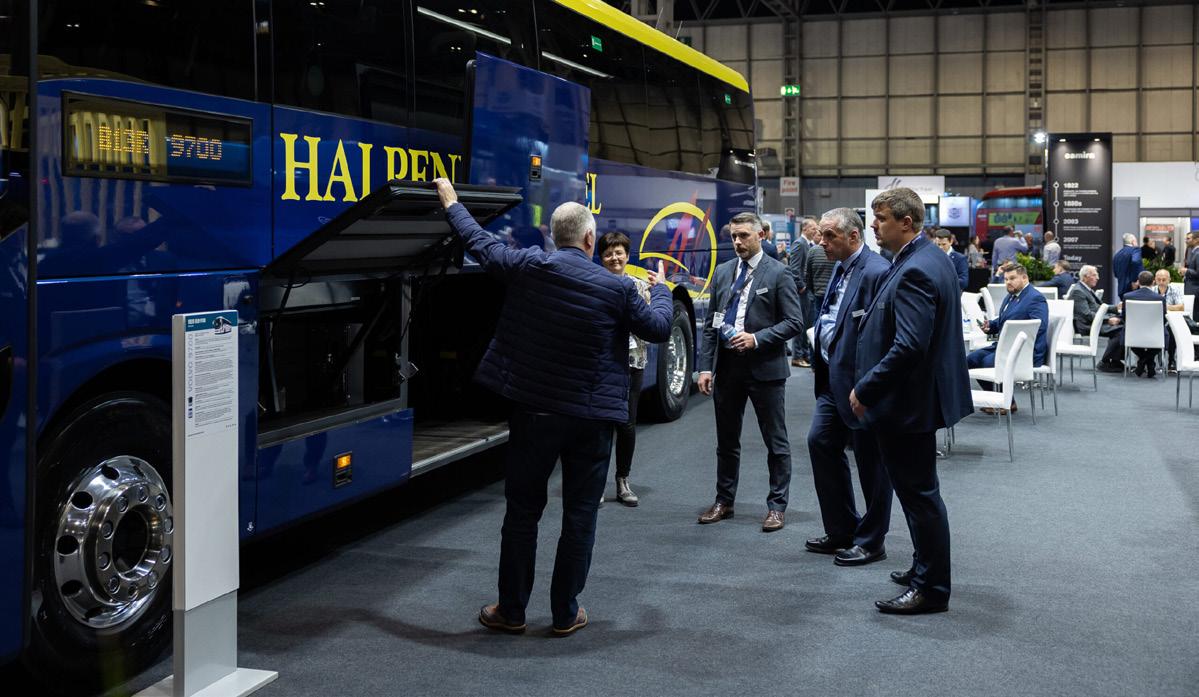
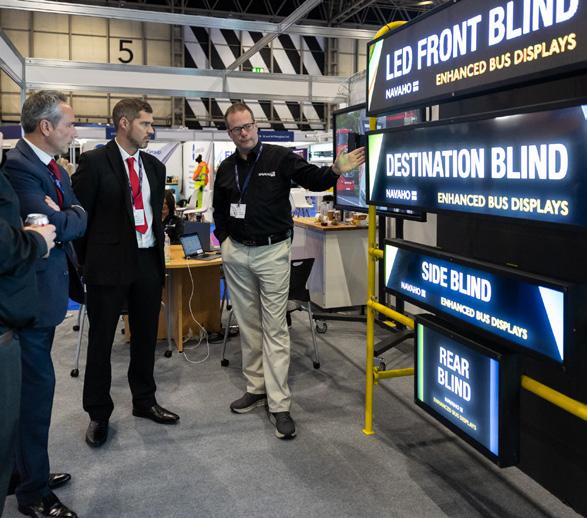
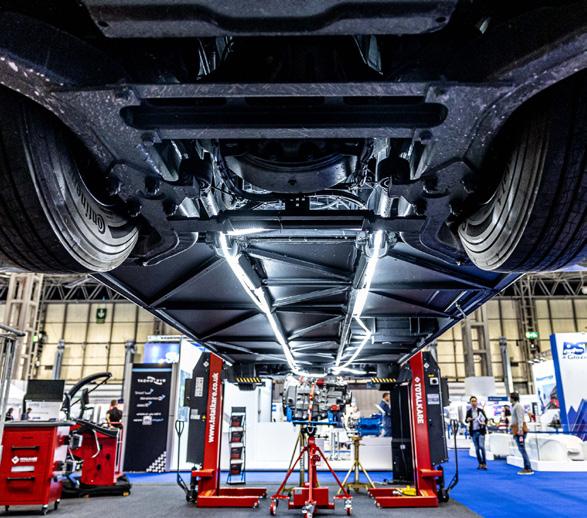

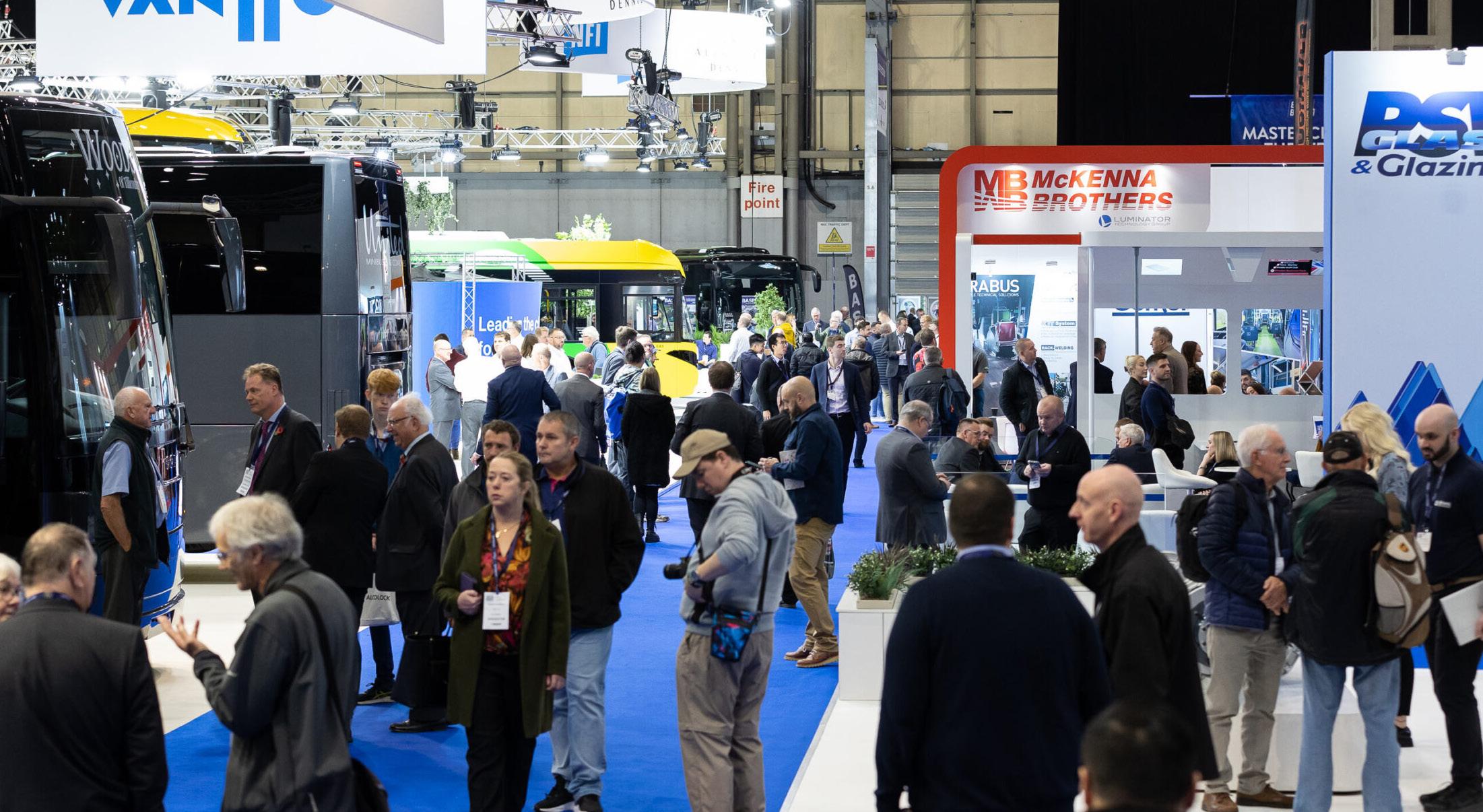
Heliox - 320
Heliox provides the ideal charging solutions to keep your vehicles running on the road smoothly and efficiently.
Kiel Group - 350
Kiel offers exceptionally modern, durable, economical seating systems for buses, with varied options for customisation.
Masats - 412
Masats S.A. produces accessibility systems for the bus and coach sectors, as well as electric and pneumatic doors for buses.
Mosaiq by Snapper Services - 198
Snapper Services provides a simple-to-use transit intelligence suite, allowing bus operators to collect and analyse data in real-time.
Navaho Technologies - 349
Navaho develops unrivalled, innovative solutions for digital information display, data centre security and managed IT services.
Tenix - 202
Tenix creates software for public and private transport companies to help them analyse and understand how their vehicle fleets are operating.
Totalkare - 80
Totalkare is the UK’s leading provider of lifting and testing solutions for heavy duty commercial workshops and bus/coach depots.
Voith - 365
Voith has equipped more than 300,000 city buses with automatic transmissions - helping people travel more efficiently and more comfortably.
Visit the Euro Bus Expo website to see the full list of exhibitors
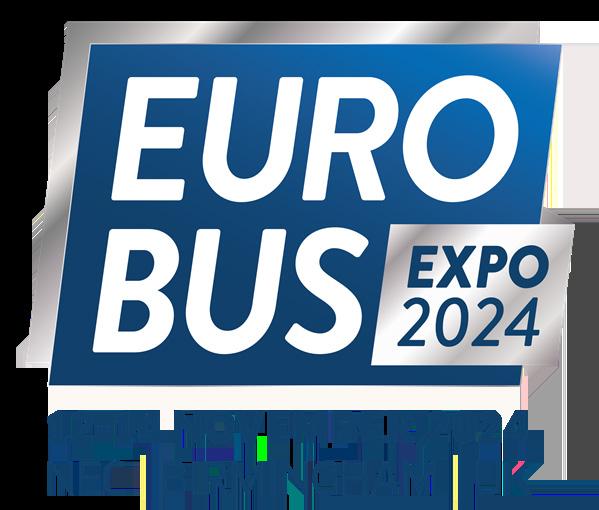


Palfinger Passenger Lifts p.14

GmbH p.17 Kiel Americas p.20 PEI Mobility p.22 PRIMA Industries S.r.l. p.25 Dellner Glass Solutions Ltd p.28

Bus Design & Interiors
The accessibility of bus and tram travel can be dramatically improved without the need for expensive infrastructure projects, notes Philipp Gerkmann, Head of Business Unit at Palfinger Passenger Lifts.
Public transport authorities have made great efforts in recent years to cut down physical barriers for people with reduced mobility like wheelchair users in order to improve access to bus and tram travel. This is often spurred on by new regulations and legislation aimed to foster inclusion in daily travel.
Many of these appeared in the 2000s, some even setting deadlines for full accessibility on public transport systems. In France this was 2015, in the UK 2020 and in Germany 2022, but while progress is being made, we as a society are still far from providing universal accessibility to bus and tram travel.
In this context it needs to be highlighted that the level
of accessibility currently in place varies significantly depending on the country and region, with larger cities faring much better than more rural areas. But while there are ongoing efforts to improve accessibility, it is estimated that in Germany alone, less than half of all bus and tram stops currently have barrier-free entrances.
Today many public transport authorities view complete accessibility as unrealistic, due to high investment costs and lack of personnel for the numerous construction projects required to make all bus and tram stops barrier-free. However, there is a simpler, more costefficient solution they can implement to improve customer accessibility: installing vehicle-bound passenger lifts and ramps integrated into vehicles’ door areas.
Ramps are inclined bridges that wheelchair users drive over under their own power to get into or out of the
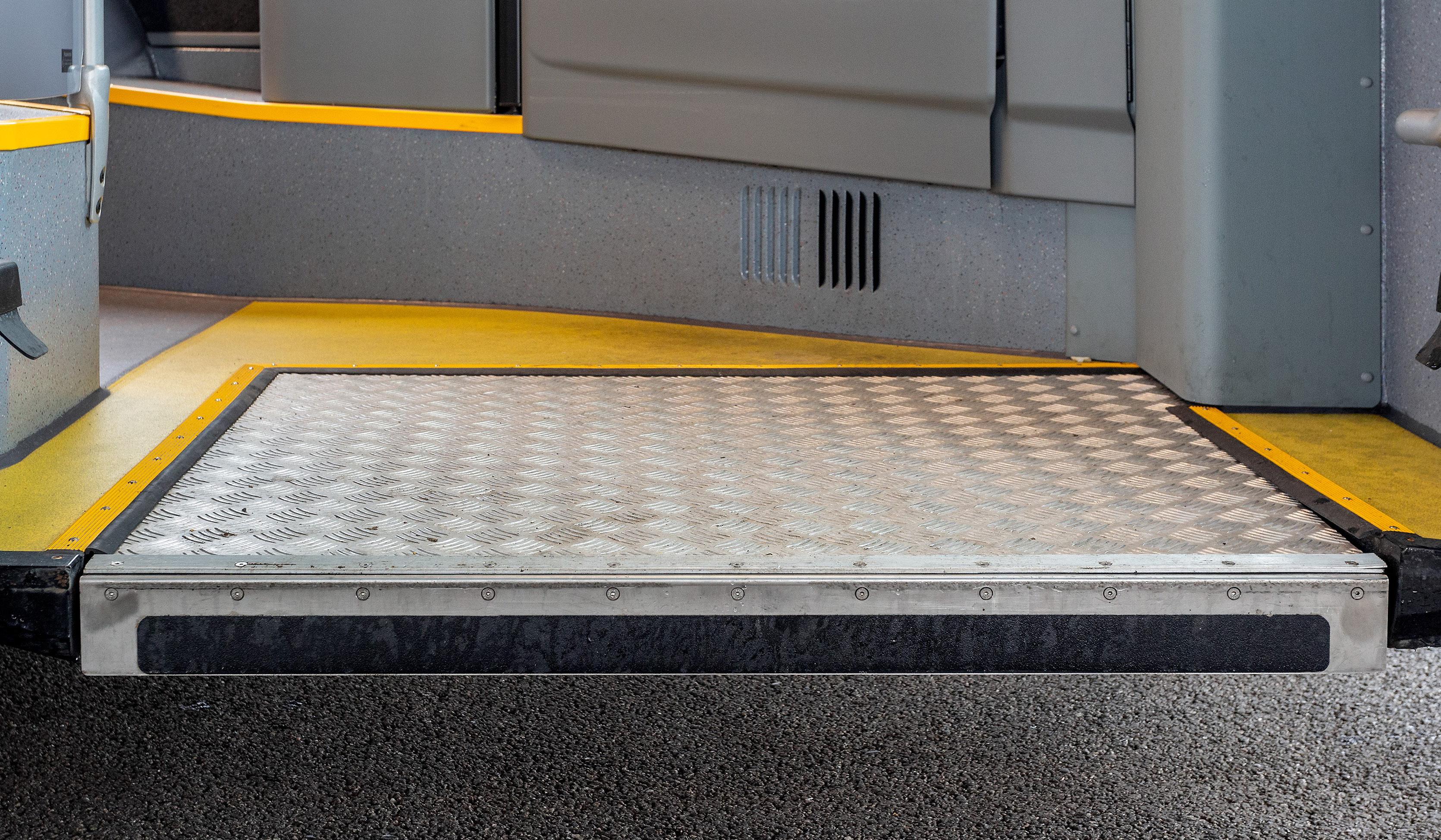
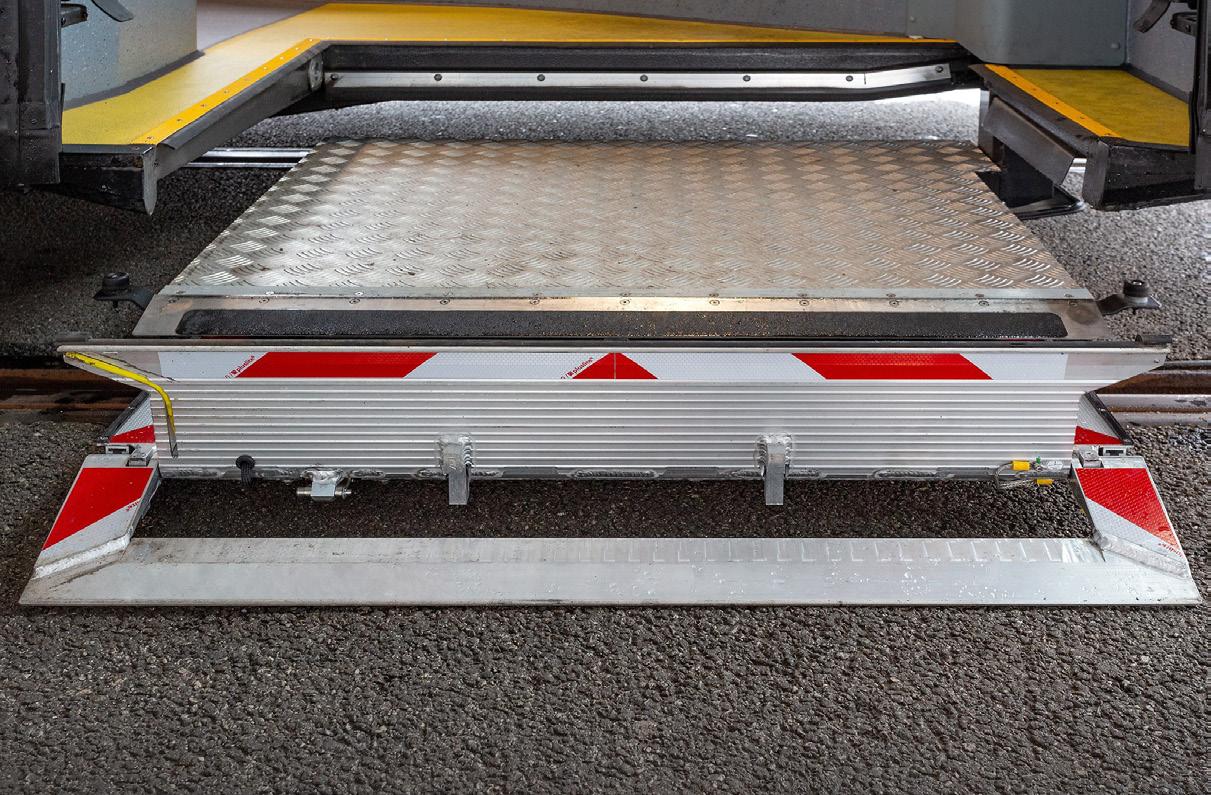
vehicle and can be manually or electrically extendable. Manual folding ramps are particularly inexpensive to equip, but are increasingly impractical in everyday passenger operations, as drivers have to leave their cabs to operate them.
A more practical solution is an electric ramp, which can be operated from the driver's cab. However, with either type of ramp, it should be noted that a bridging angle of 6.7° to the floor line must not be exceeded otherwise the ramp is too steep for wheelchair users and there’s a risk of tipping backwards.
Therefore, at stops with greater height discrepancies, ramps can paradoxically become barriers themselves.
This issue can be avoided using lifting platforms: these systems are integrated into the vehicle floor of the door area by means of a column or cassette. Due to this wheelchair users can be transported vertically from the level of the ground to the level of the vehicle floor.
Once a person is on the lift platform, automatic rolloff safety devices activate, and the platform raises to vehicle floor level. The wheelchair user can also exit the vehicle in the reverse order.
As the platform does not change its horizontal position during the lifting process, it is possible to ascend at a small angle and bridge level differences of up to 300mm. A lift is also always operated from the driver's platform and, together with camera monitoring, provides a safe solution for wheelchair users and vehicle operators.
Like any technical system, ramps and lifts are subject to maintenance requirements that must be taken into account in the life-cycle costs of a vehicle. Overall, however, purchasing costs and maintenance of these systems will be significantly lower than a line-specific conversion of several stops. This is especially beneficial for stops that are difficult or impossible to modify structurally, such as those in landmarked historic city centres or in rural areas.
Palfinger, with over 30 years' experience in the transport industry, offers customised lift and ramp solutions. Our factory near Bremen, Germany, has produced more than 7,500 ramps and 2,400 medilifts for clients including Siemens, Hess, Daimler, Skoda, Solaris, Irizar and Alstom.
Two of our key products are the Medilift LB 300 Column Lift for buses and the Medilift CL 300 Cassette Lift for trams. These fully automatic electric lifts are designed for low-floor vehicles, providing comfortable entry and exit for wheelchair users from kerb or floor level. Safety features include automatic roll stops, safety markings, anti-slip surfaces and integration into the vehicle's safety circuit.
If you want to see these systems in operation, you can do so in cities such as Bremen or Munich, where this strategy for meeting accessibility regulations is already being implemented on tram lines and individual bus routes. For those further afield, you can also watch the LB 300 Column Lift in action online at Bus-News.
For further information on our lifts and ramps, please visit our website or contact our sales and service representatives.
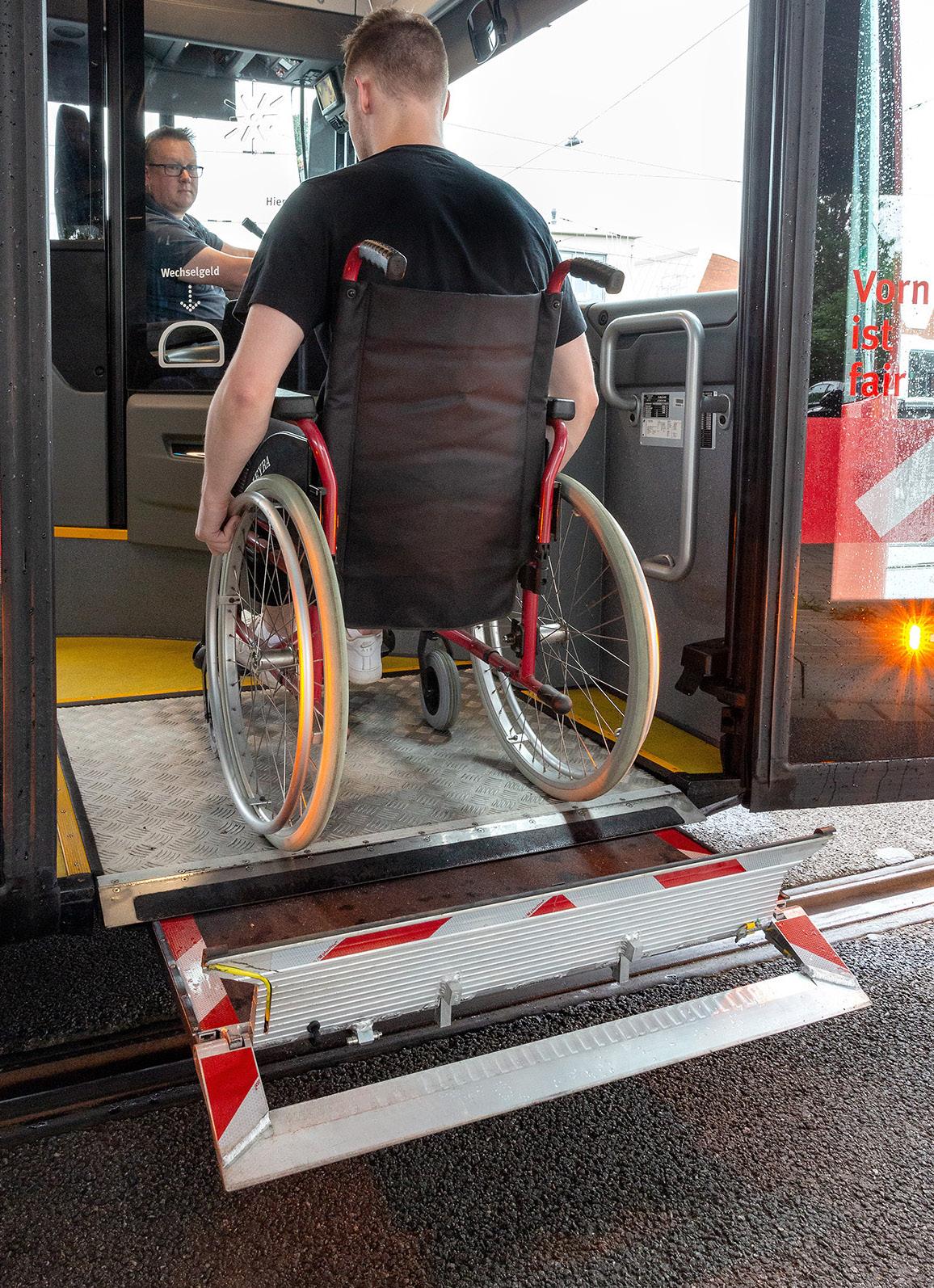



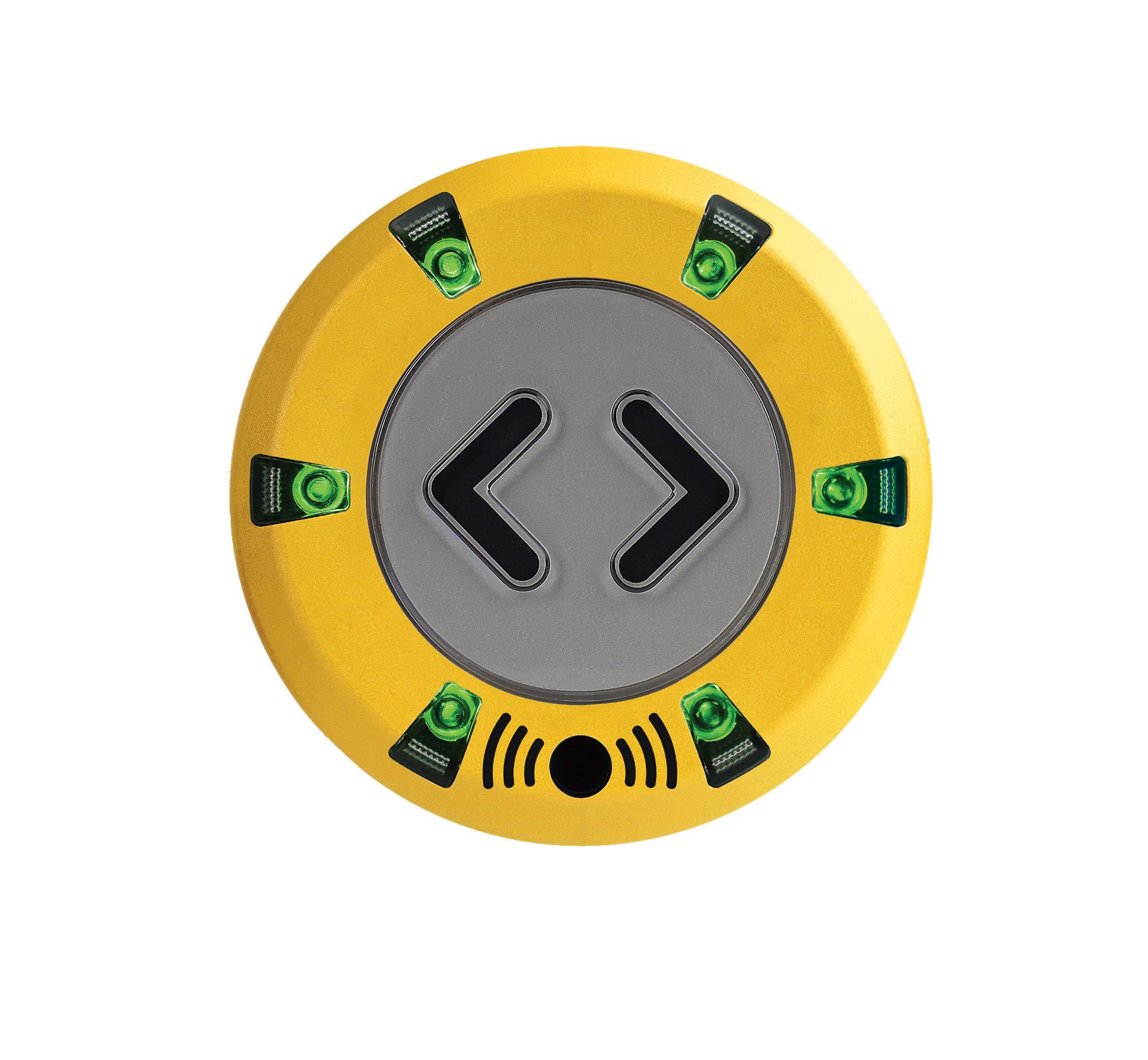
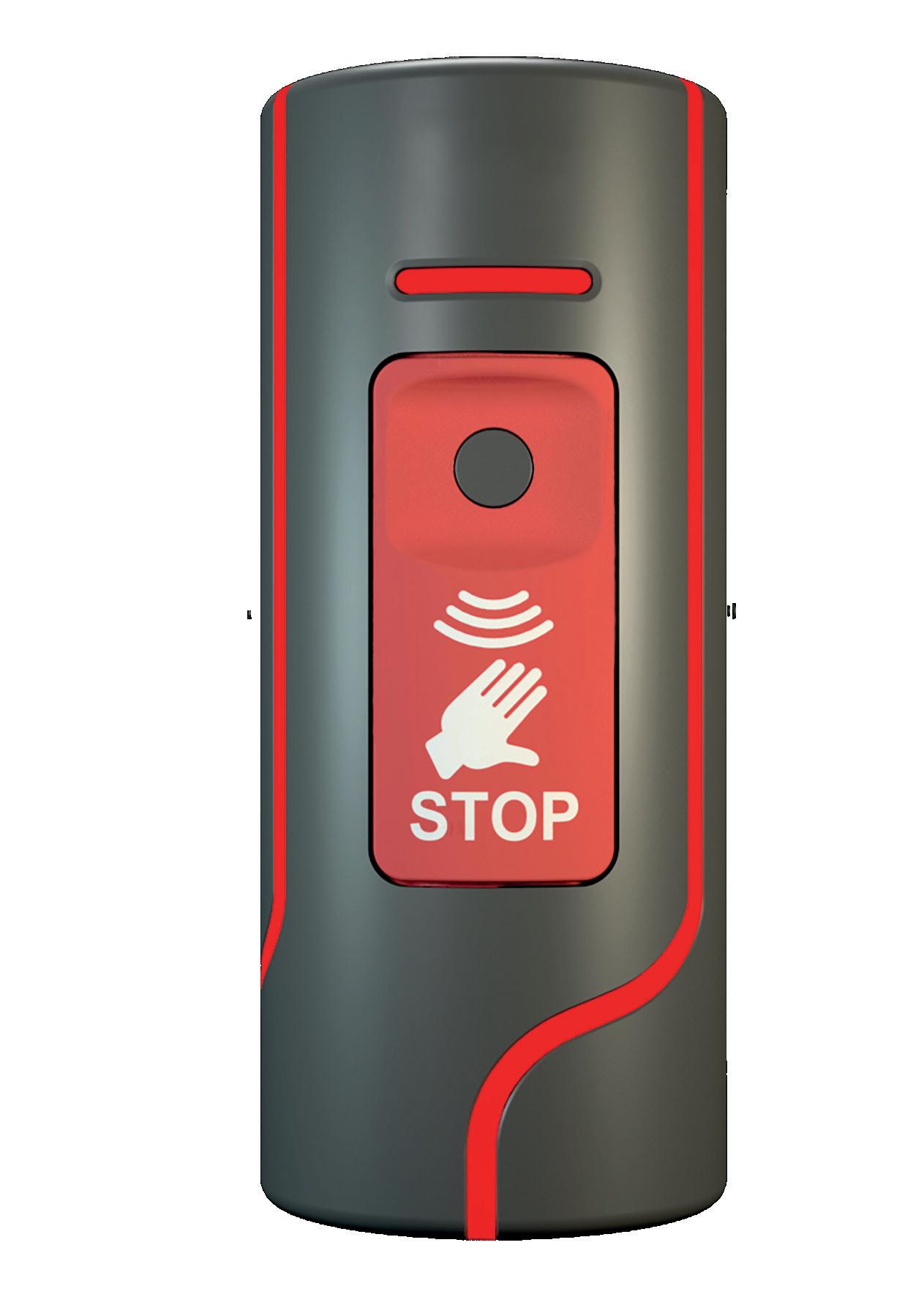



TEAM
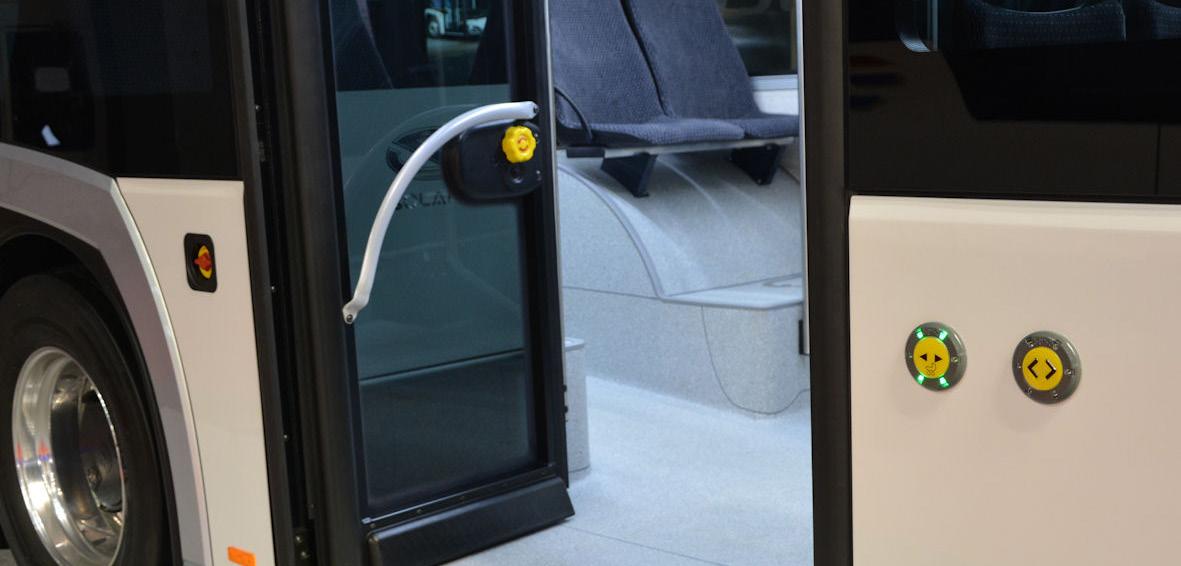
TSL-ESCHA and MAFELEC are jointly developing a comprehensive range of innovative solutions designed to enhance comfort and safety in both urban and longdistance public transport.
From intelligent lighting systems to intuitive control elements, these solutions significantly contribute to a more comfortable and secure passenger experience.
With a strong focus on continuous innovation, TSLESCHA and MAFELEC are setting new standards in passenger comfort. Both companies are part of the MAFELEC TEAM – a privately owned group of nine specialised companies offering expertise in humanmachine interfaces (HMI), lighting systems and sensors. Their extensive knowledge spans across various
industries, including buses and railways, commercial vehicles, industrial applications, energy, defence, aerospace and elevators.
With over 700 employees, the group delivers innovative, tailor-made solutions to customers worldwide. Under the motto ‘One Team – One Company’, their combined global expertise drives the development of modern solutions for the transportation sector.
With the innovative expansion of the PK5x series, TSL-ESCHA and MAFELEC focus on proven quality and enhanced functionality. The PK55 combines familiar design with advanced features, excelling in safety, efficiency, flexibility and intelligence for door applications.
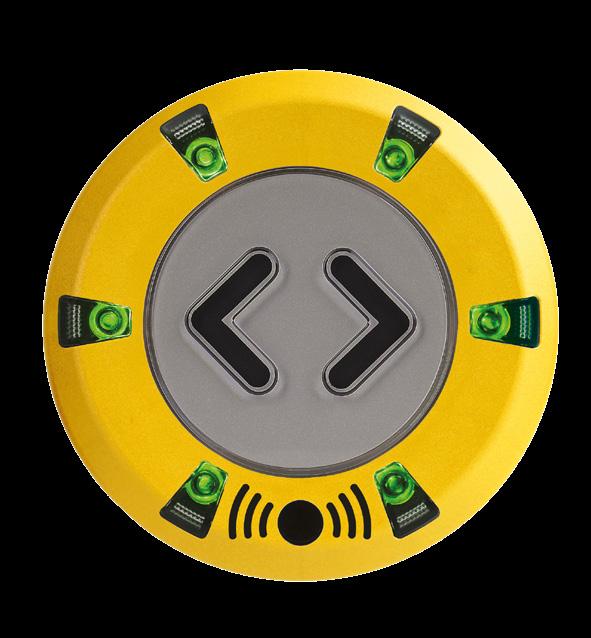
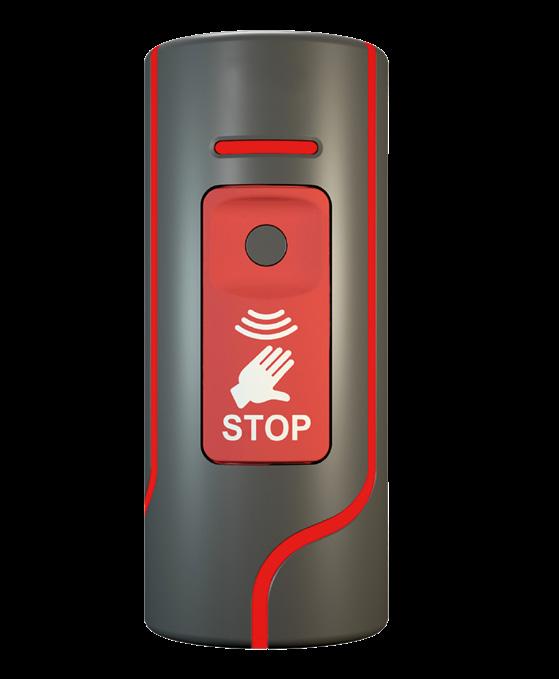
The PK55 embeds tactile actuation which ensures reliable and haptic feedback to comply with PRM requirements. Furthermore, the PK55 can be equipped with the touchless activation option M-Safe, which offers hygiene benefits and thus represents an ideal solution, especially for public transport.
Another highlight is the integrated 8mm plug connection on the back of the push button for 24VDC applications. This compact, round and mechanically reverse polarity protected IP67 connector offers a high degree of reliability for a simple 3 to 5-pole connection that complies with all transportation standards (ECER10, EN 50155, EN 61373, EN 45545-2...). Additionally, this reduces the number of connections in the door profile. This simplifies installation and reduces maintenance and repair work.
The expansion of the proven PK5x door opening push button series offers a high level of convenience, safety and efficiency to meet the needs of passengers.
Handrail Push Button with Touchless Function
The M-360 is a triple push button with an innovative and elegant design that is mounted on the handrail or interior walls of all transportation vehicles requiring a stop request command (buses, trains, trams).
Accessibility to the stop request function is total for all passengers, whatever their position in the vehicle, thanks to its three large actuation and lighting zones
visible at 360 degrees in the pole-mounted version. The haptic feedback (click effect) associated with the change of lighting colour of all the buttons installed in the vehicle confirms that the request has been taken into account.
Colour, labelling, relief/braille and lighting are fully customisable to meet the design requirements of customers.
Additionally, MAFELEC has developed the M-360/WT and M-360/PT with an innovative touchless activation feature to meet the growing demands for passenger health and safety. The integration of the M-SAFE technology allows passengers to choose between tactile and touchless activation, enhancing the flexibility and user-friendliness of the push button. The distance and activation time of the touchless M-Safe technology can be adjusted to prevent unintentional activations.
TSL-ESCHA and MAFELEC offer a wide variety of handrail push buttons. Ranging from simple handrail push buttons to backlit indicators and touchless functions, these product families are highly versatile.
The HST series, first produced by TSL-ESCHA in 2004, has been further developed to offer a version with acoustic, visual and haptic feedback all in one. The HSTIAV model (‘I’ for ‘illumination’, ‘A’ for ‘acoustics’ and ‘V’ for ‘vibration’) features dual-colour lighting in red and green, along with vibration and acoustic feedback that activates briefly upon pressing the push button. This ensures that feedback is visible, audible and tangible. The goal is to provide passengers with an increased sense of security through multiple feedback options when activating the push button.
www.tsl-escha.com
www.mafelec.com
+49 2353 66796-0 info@tsl-escha.com


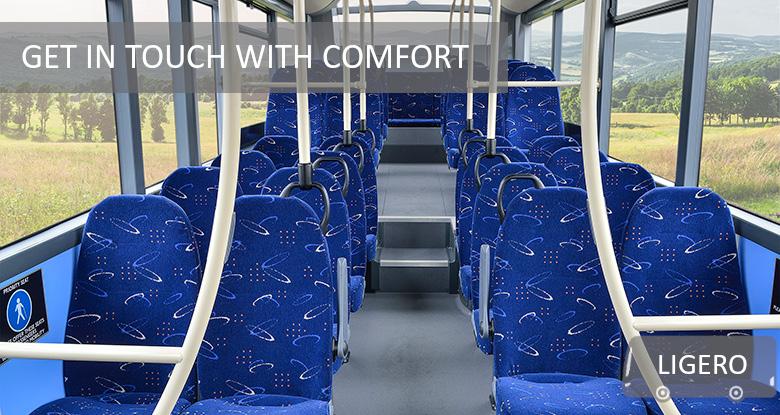
Kiel Americas, as a part of the Kiel Group, has been providing seating solutions for the North American mass transportation industry since 2009.
Kiel Americas employs approximately 150 employees and has full R&D and manufacturing capabilities at its facility located in Bellwood, Illinois; however, we are also part of a global network, with additional production facilities and technical resources in Germany, Poland, Turkey and Macedonia.
Kiel Americas offers a wide range of passenger seating systems for local, regional and intercity transport. In the best Kiel tradition, all our seats combine quality,
individuality, cost-effectiveness and safety with innovative ideas and attractive, lightweight designs. With a commitment to ergonomic design, durability and space optimisation, we’re not just seating passengers; we're elevating their experience.
With safety always at the forefront of our designs, Kiel engineers have experience working and conducting crash testing in many different countries. Because they incorporate standards from a variety of safety boards around the world, Kiel passenger seats have achieved high-quality standards.
Kiel Americas utilises modular, recyclable construction systems, aiming to conserve resources and provide as many environmentally friendly options as possible.
Most importantly, a Kiel seat can be reupholstered at any given time.
It’s Up to You® can create a VIP, Luxury, Comfort, or Basic seat as follows:
VIP: Available for 2+1 seating, elaborate luxury upholstery with full leather, headrest with movable and height-adjustable, additional wider seat back, upholstered armrest and luxurious comfort upholstery, newspaper net, table and ‘Smart Fix’, optional USB socket, monitor, integrated height-adjustable threepoint belt, optional inductive charging in headrest.
LUXURY: Opulent luxury upholstery with full leather, wide head piece with movable and height-adjustable headrest, magazine net, table and ‘Smart Fix’ as with the ‘Comfort’ version, optional USB socket and monitor, optional built-in, height-adjustable three-point belt, optional inductive charging coil (Wi-Fi charging) in the headrest.
COMFORT: Standard upholstery or optional leather upholstery on the seat cushion and back, wide and comfortable leather head piece, wide elegant table, magazine net, rubber clamp fitting on the rear of
the headrest (‘Smart Fix’), optional built-in, heightadjustable three-point-belt, optional inductive charging coil (Wi-Fi charging) in the headrest.
BASIC: Simple fabric upholstery with leather headrest, fixed headrest, model-specific table and magazine net option, handles with coat hook and three-point belt on the outward side.
When it comes to designing and producing the optimal seat for a given application, Kiel Americas stands behind the slogan ‘It’s up to you’. For instance, this can mean a steel structure with steel components, or a composite material base. It is not only the travellers who have specific requirements for seating: Kiel’s customers – the manufacturers of buses, coaches and minibuses – expect seats that are increasingly economical, robust and lightweight.
Simply put, it’s up to you.®
For more information visit www.kiel-seating.com or email pmure@kielamericas.com
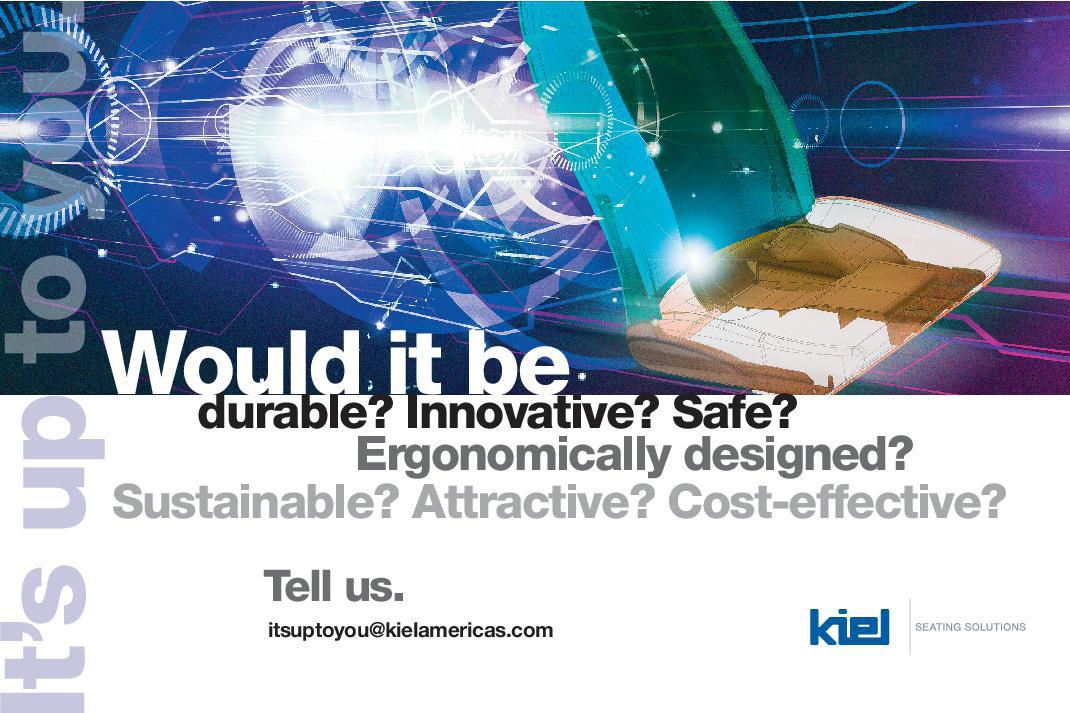
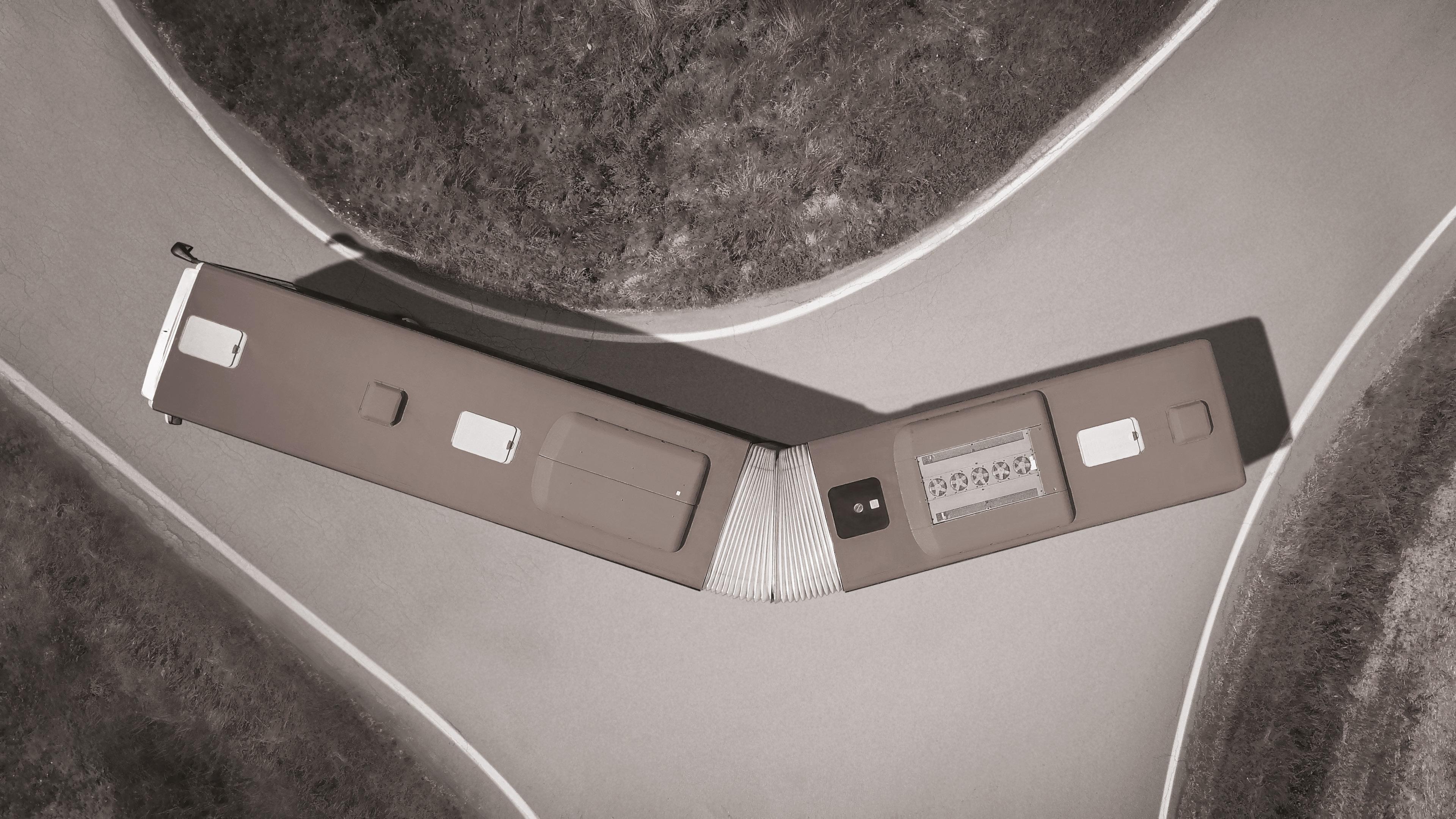

Directory
Bus Design & Interiors
Located in Emilia-Romagna, in the heart of Italy’s Motor Valley, PEI Mobility was born in a context of excellence and over the years has developed a wide range of products for interconnection, becoming a key partner for leading manufacturers of articulated buses.
Actually, in addition to the already established production and sale of bus bellows, started twenty years now, the available range of articulations has proven to be particularly interesting, providing the market with new products both in terms of production technology and function.
PEI Mobility’s range of articulations includes models suitable for all kinds of chassis.
We have designed and produced articulations for all configurations on the market, and we propose ourselves as a universal partner for all manufacturers of articulated buses.
The bus articulation systems of PEI Mobility are supplied with microprocessor-controlled electronics.
The Stability Control Unit (SCU) communicates with the vehicle and allows real-time adjustment of the hydraulic system, adjusting the vehicle’s behaviour in potentially critical situations.
It has been created in accordance with the latest international standard for functional safety ISO 26262 and is ready to fulfil the necessary requirements to comply with recent European cyber security regulations.
We have also recently introduced a new joint dedicated to 'puller' vehicles with a different traction system.
For this category of buses, a simpler articulation, which does not require a specific damping system and a stability control device, can be anyway effective.
PEI Mobility has thus introduced a more essential but technologically advanced product, able to meet completely the needs in this category of vehicles, currently mainly represented by full electric buses and bus rapid transit (BRT) systems.
We prioritise sustainability by using minimal adhesives and solvents in our fabric production, making our bellows far more eco-friendly compared to traditional products. Our investments in R&D and technological upgrade extend to our production facilities, featuring fully automated lines that ensure precision and significantly reduce material waste.
Efficiency, flexibility and sustainability are hallmarks of our engineering expertise, supported by IATF automotive quality certifications and continuous product research and development, as well as optimised manufacturing processes.
PEI Mobility remains dedicated to delivering superior, sustainable solutions that meet the evolving needs of the transportation industry.
Watch our video to find out more.
www.peimobility.com

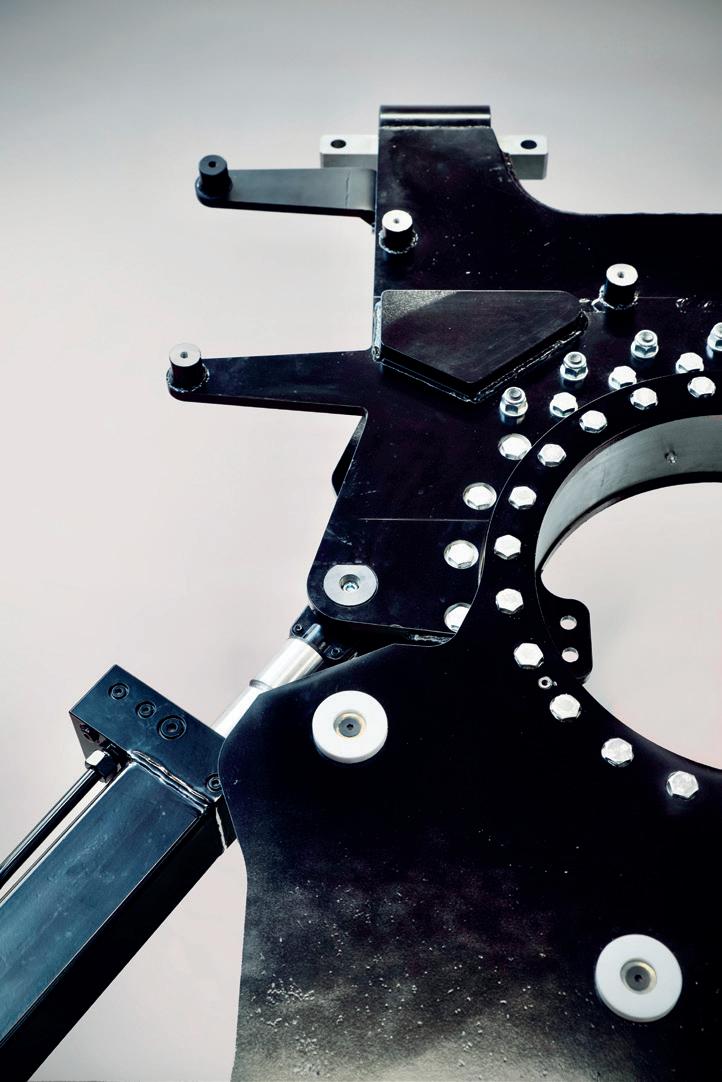
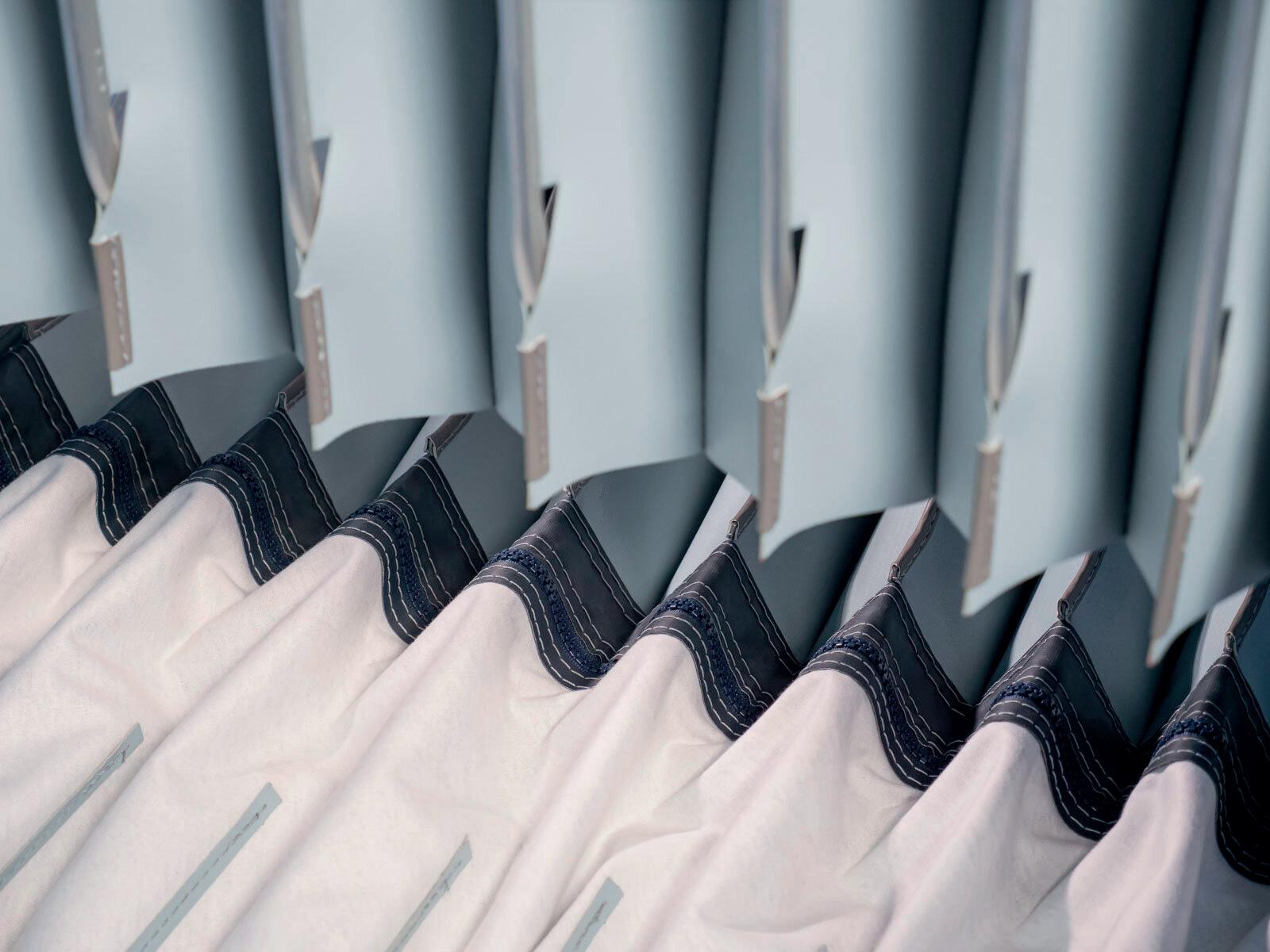
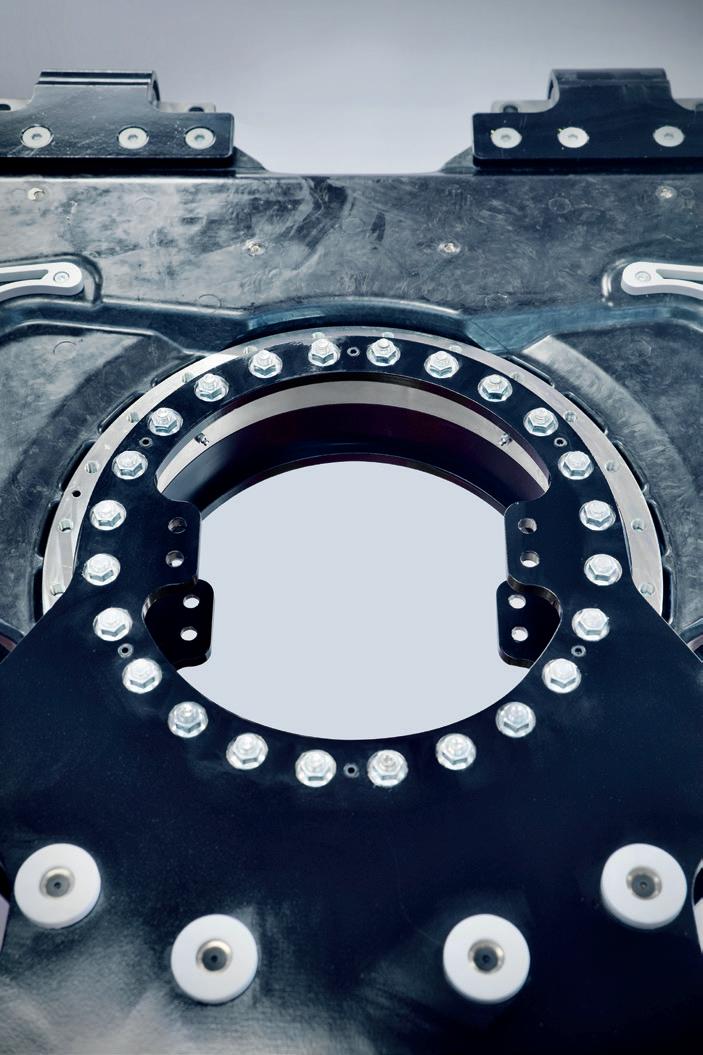
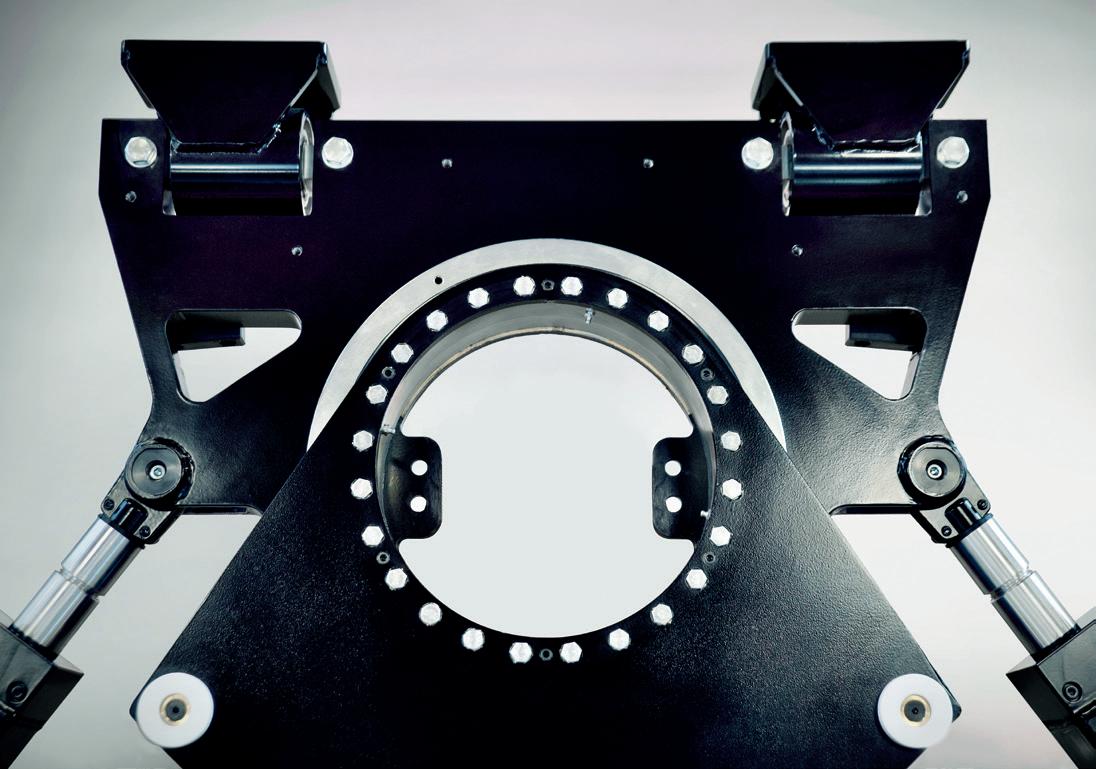

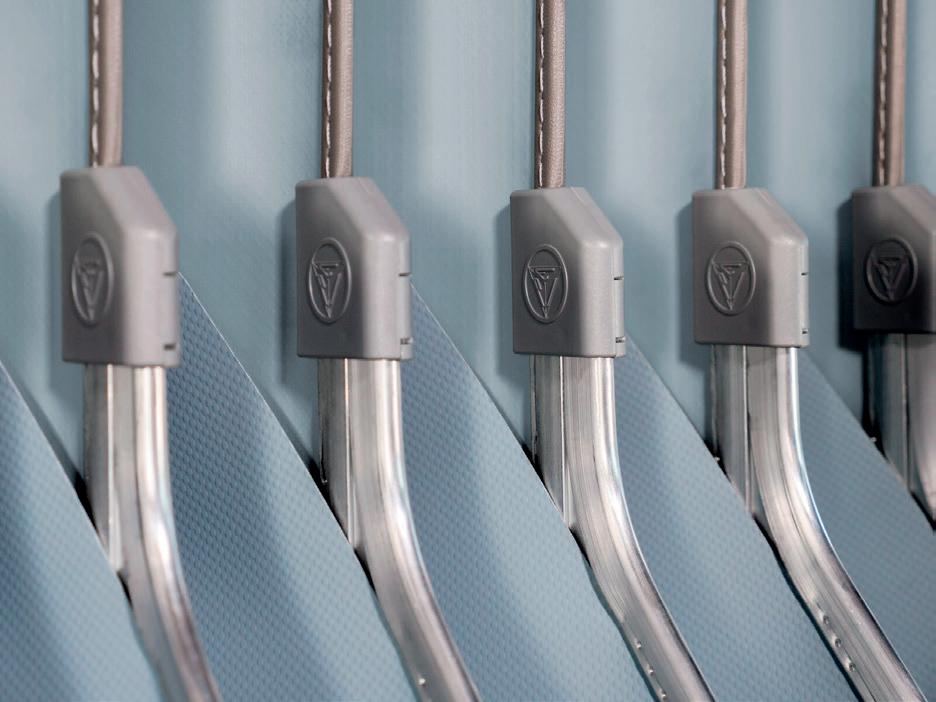
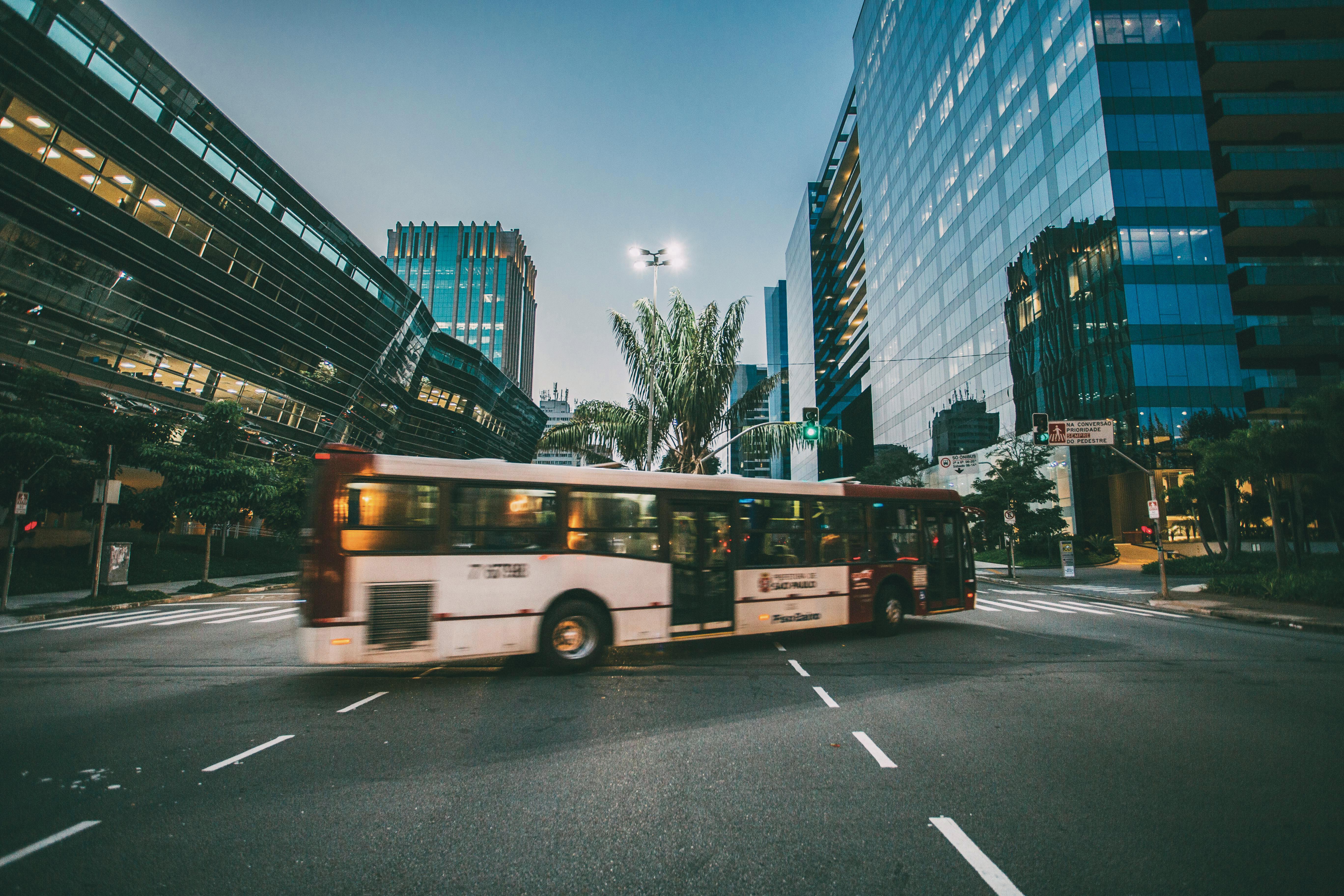

Product development is a trip: the final destination is important, but what also makes a difference is what you do and what you learn along the journey.
Prima Industries’ final destination is a new generation of accessories that can contribute to reducing the automotive footprint in our society. The company estimates at least three paths to improve its sustainability:
1. Improving the factory footprint by working on energy, the supply chain and waste
2. Stimulating the suppliers to adopt virtuous behaviours
3. Reducing products’ impact
But how easy is it for a small-medium enterprise not only to pursue but also to actually implement these noble targets?
Talking about the improvement of the factory footprint, Prima Industries doesn’t start from scratch. Indeed, the ISO 14001 environmental certification, which Prima first obtained in 2016, already includes the milestones of the responsible attitude a company must endorse to be considered sustainable in today’s world.
Of course, there are other things to do, like investing in alternative energies and re-designing the supply chain, but the road is clear and the guiding principles of the Italian manufacturer are for sure a big help in achieving the set goals.
The suppliers, and their virtuous behaviours, are fundamental factors in reducing a company’s footprint, but this also requires a proactive approach from the
vendor. Improvement proposals are more effective when adopted from both sides and a shared vision of the future can also successfully influence the day-to-day business.
According to Mr Silvio Alberti, CEO of Prima Industries, the third goal is the one that takes more time to be implemented and in this case, the efforts need to start from the very early stage of a project. “In the design phase,we must try to reduce the product’s weight and we also try to use at least a percentage of recycled material.”
The benefits of such choices taken at the very beginning of the production phase inevitably also influence the industries where these products will be deployed.
Nowadays, one of the main goals of the OEM players and bodybuilders is reducing the vehicle’s weight and, consequently, its carbon emissions.
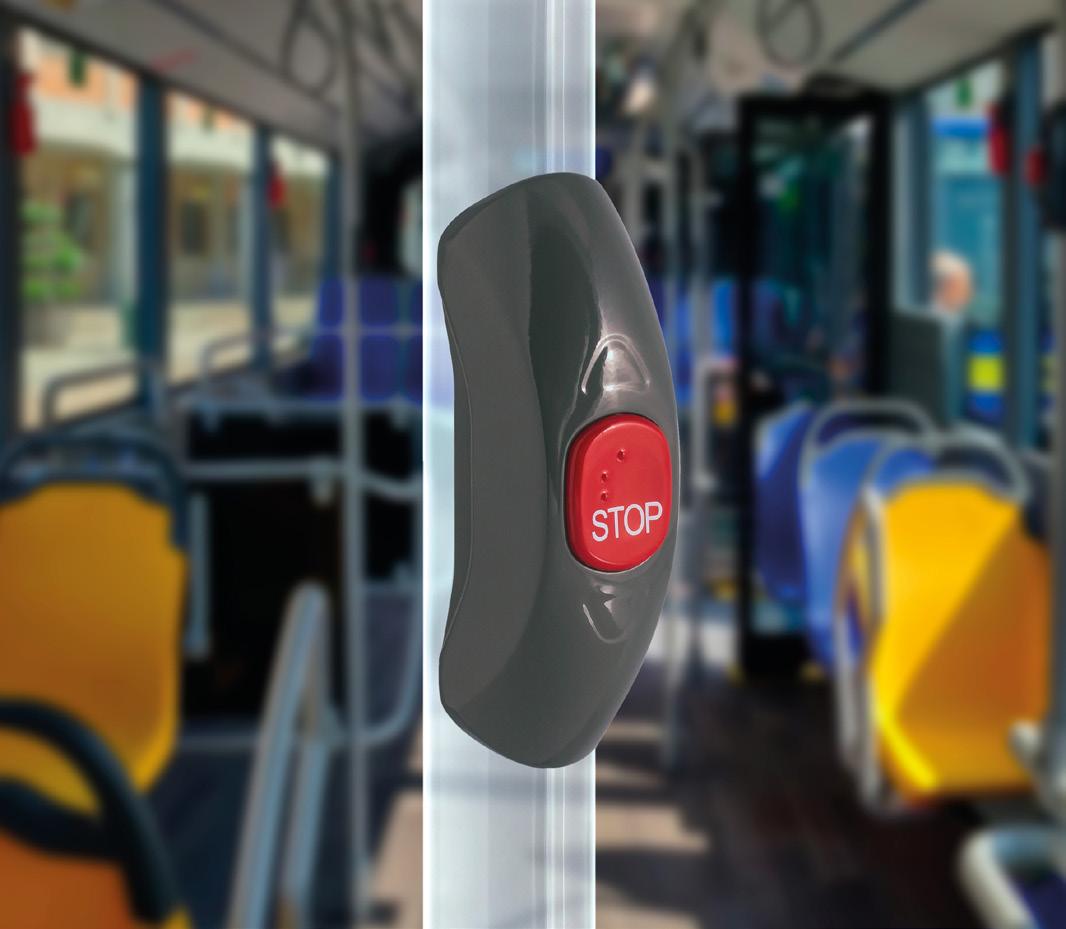

presented during Busworld Europe 2023 and will be launched on the market by the end of 2024.
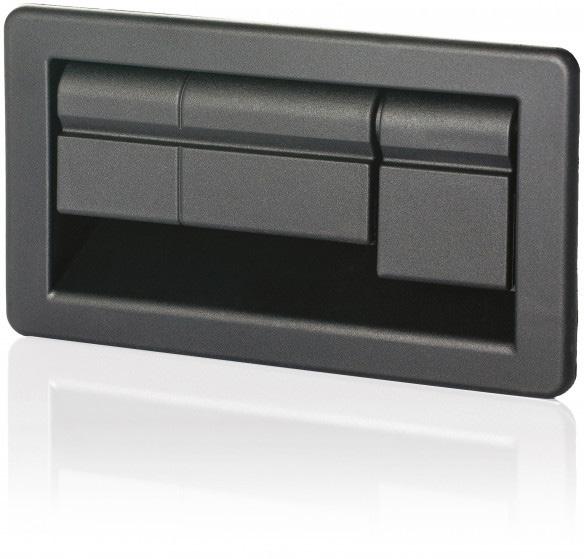
Of course, what characterises a wireless system is the absence of cables and wires in the pushbuttons. Still, in this case, there’s another ‘missing’ element that makes this product even more captivating, innovative and lightweight: no batteries are required for the pushbuttons to operate, granting a longer life cycle to the system. Especially in double decker buses, it’s easy to understand the difference this ‘absence’ can make when considering the vehicle’s total weight.
Prima’s wireless system will be available on the market by the end of 2024, both in the wall and the pole version. There will always be the space for tradition, so for the lovers of ‘the good old’ wired pushbuttons, the same design will be available for the cabled ones.
Prima’s catalogue offers many other allies in the quest for weight reduction and the plastic handrail supports are one of these. Here, the range is huge and includes different fittings, sizes and colours.
In the light diffusers category, the latest addition is the P567 spotlight, designed to light up the entrance area in the vehicle. Extremely lightweight, its performance allows the use of only one piece where usually it takes two diffusers to properly light the area. Also, thanks to the fixing springs, it can easily be adapted to many different surfaces.
Especially on coaches, the number of the external

handles that must be installed can be significant and so their weight adds up. Again, the specialisation of Prima Industries in plastic injection moulding comes in handy!
From the luggage door to those for the driver and the passengers, the catalogue will have something for all tastes.
What distinguishes the different available handles though, is not only the application but also the operating method: indeed, in addition to the traditional manual handles, for every model you’ll also find the electric and the pneumatic ones.
The catalogue of Prima Industries is huge and these are just some of the items manufactured by this company. In addition to this big basket though, Prima is always interested in developing new items upon the client’s request, sharing ideas and suggestions.
Sustainability needs to become an ever increasing part of the guiding principle of doing business today and it’s a long way, but for sure Prima Industries can be a great partner to walk with. www.primaautomotive.it


Dellner Glass Solutions is a part of the global Dellner Group, a worldleading, customer-oriented supplier of sustainable products and solutions across the transportation, material handling, wind, marine, oil and gas industries.Headquartered in Borlänge, Sweden, the Dellner Group boasts an annual turnover of more than EUR 200m.
Our strategic approach focuses on designing, engineering, manufacturing, testing and supplying specialist glazing products such as bodyside windows, manual doors and emergency exit doors, driver’s cab
signal windows, driver cab protection (doors and screens) and emergency egress windows.
Our bodyside window systems involve fully framed windows being permanently fixed to the vehicle structure (usually through bonding) and on removal of an internal profile the glass only can be removed and replaced within a few minutes. Our hopper windows can be supplied as single or twin opening vents for passenger use; however, we also have options to provide locking hoppers and similar options exist for our sliding window designs. Our range of bodyside windows includes options on glass thickness, as customers seek to reduce weight, and we can provide glass thickness as thin as 3mm to work within our framing systems.
Driver protection screens have been supplied by our Tamworth site for nearly 30 years. Developed originally as assault doors only, these became more of a necessity for the bus market, and we designed forward/front screens to match – to provide full cab protection. The doors and screens are a mixture of aluminium and polycarbonate fabrication, designed to protect drivers from unruly passengers, although in the current climate serve also as protection screens for airborne viruses.
The assault doors can be supplied with fully fixed polycarbonate glazing or sliding panes (lift or drop) with intermediate open positions. The lower part of the door is provided with aluminium panelling or can be incorporated into plastic/GRP skins. As a core product for our Tamworth site, we have the ability to mark our polycarbonate to ECE R43 glazing requirements for vehicles.

products tailored to our customers' specifications, with sustainability integrated into every step.
The front screens can be shaped to meet the visual needs within a cab (reflection, position of mirrors etc.) and fixed back to the cab desk and upper bulkhead, to ensure a solid fit within the vehicle. Once installed with the door in situ, they provide a safe enclosed environment for the driver.
Although we design and manufacture the bulk of cab protection products for OEM builders, our designs are flexible enough to be amended to suit any vehicle cab, so even vehicles in service can be retrofitted with our cab protection systems – ensuring your staff are safe at work.
At Dellner Glass Solutions, sustainability is at the core of our operations. We are committed to minimising our environmental impact through innovative practices and sustainable manufacturing processes. Our manufacturing units underscore this commitment: our Tamworth site is dedicated to metal fabrication and assembly work, and our Consett site produces specialist glass products. Both sites are equipped to deliver complex, high-performance product assemblies for the transport, architectural, security and military markets, all while adhering to sustainable practices.
The Tamworth manufacturing site features multiple CNC saws, CNC machining centres, forming machines, welding capabilities (EN15085), sheet metal fabrication, in-house wet and powder coating, a certified bonding area (DIN 6701-A1) and various assembly sections. These capabilities allow us to create a wide spectrum of
Our Consett facility is equipped with a toughening furnace, printing, lamination, including clean rooms, multiple bending furnaces and autoclaves. We produce thousands of glazing systems annually, ranging from simple laminates to complex bends and curves, all while maintaining a focus on reducing our carbon footprint.
Our success relies not only on our comprehensive equipment and capabilities but also on the expertise and dedication of our employees. Many of them have devoted their careers to our business, bringing invaluable knowledge and passion to our mission. Together, we continually strive to be our customers' number one choice by delivering innovative, highquality and sustainable solutions.
In short, Dellner Glass Solutions is a glass and fabrication specialist for the global transport, architectural and security markets. We create added value to your product, project and processes with sustainable industry leading engineering and manufacturing capabilities.
For more information please contact
www.dellnerglass.co.uk
+44 (0) 1207 500000 info@dellnerglass.com

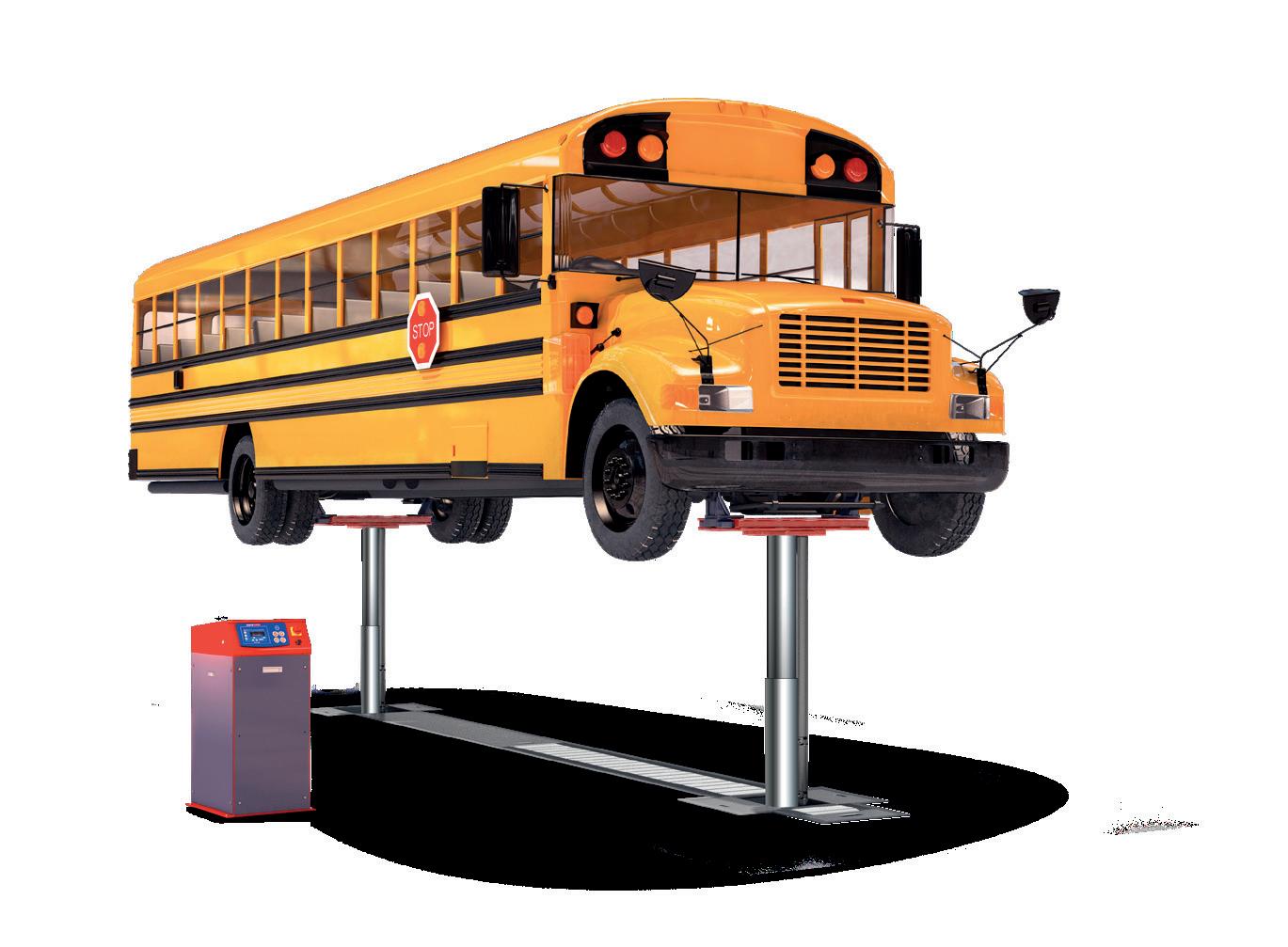

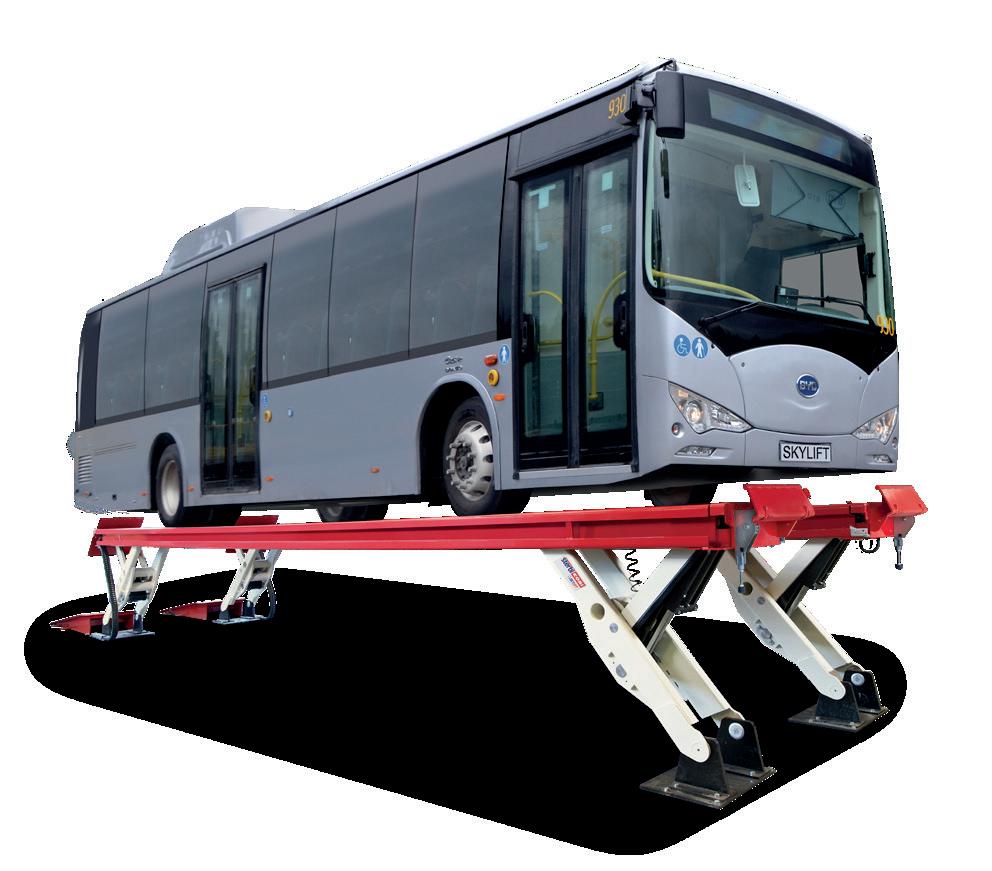

Stertil-Koni is worldwide market leader specialised in the lifting of heavy duty commercial vehicles. Quality, safety, reliability and ultimate liberty of lifting. A complete range of heavy duty lifts designed specifically to answer the demanding needs of the market for vehicle service, repair and maintenance. Stertil-Koni products are developed and manufactured in-house by a highly qualified team of experts.

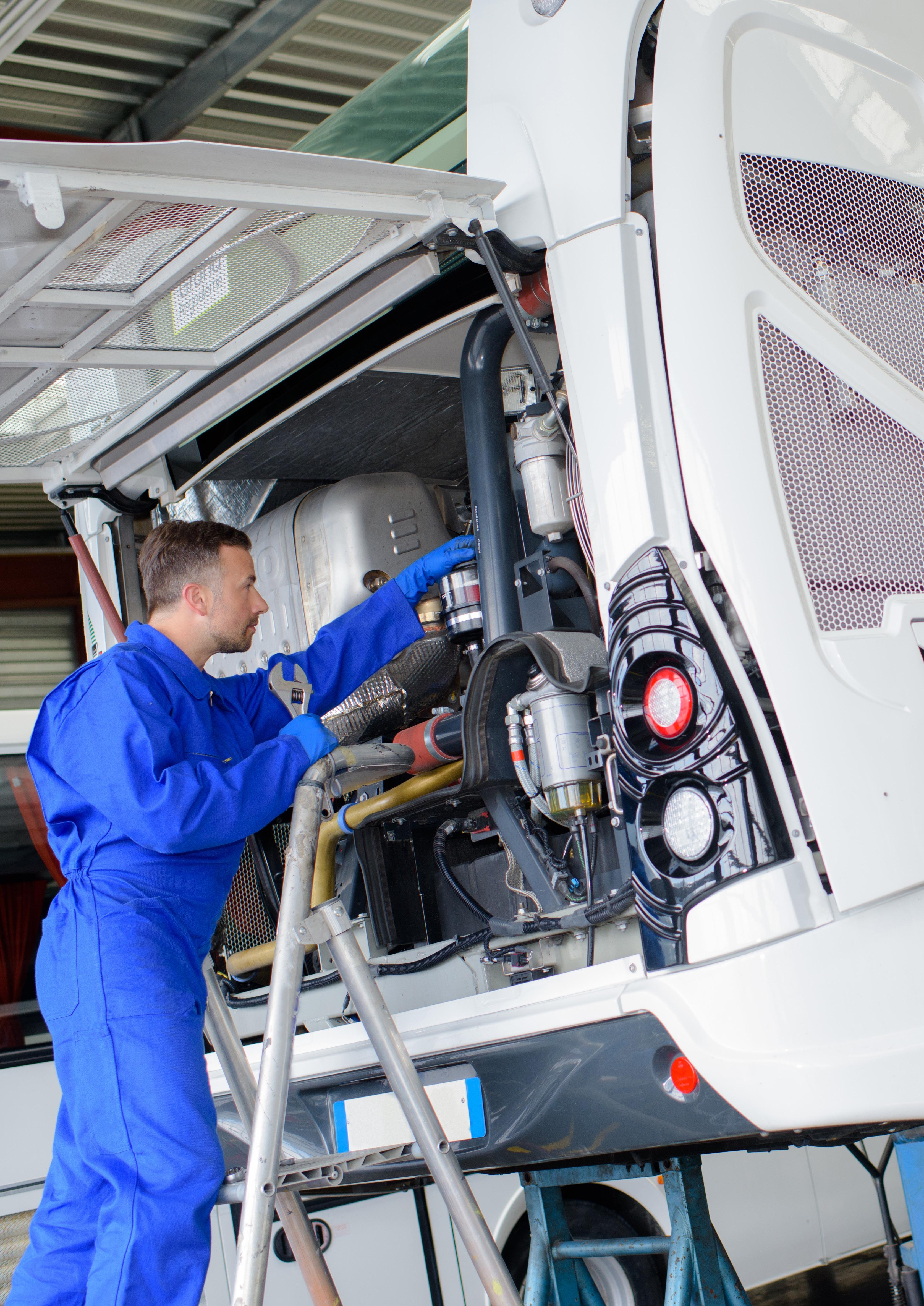
Totalkare Ltd p.32
Wrightbus Invests in Totalkare Column Lifts for NewPower Facility Stertil-Koni p.35
The ‘Helping Hands’ in Any Heavy Duty Workshop
Columbus McKinnon p.38
Columbus McKinnon Supplies Height-Adjustable Roof Working Platforms for Maintenance and Repair of Bus Fleets



Totalkare, the UK’s leading provider of heavy-duty lifting solutions, is thrilled to announce its T8DC cable-free mobile column lifts have been installed by Wrightbus at its state-of-the-art NewPower facility in Bicester, Oxfordshire.
This strategic investment includes six sets of Totalkare’s highly-regarded mobile column lifts, integral to the ambitious new facility’s mission to transform older diesel buses into zero-emission electric vehicles.
NewPower represents a significant leap in the bus
industry's drive towards sustainability. With the capacity to re-power midlife diesel buses into electric vehicles within just three weeks, NewPower will substantially contribute to reducing urban air pollution and advancing the decarbonisation of public transport.
Karsten Hall, Manufacturing Engineer at Wrightbus, expressed enthusiasm about the partnership with Totalkare:
“We are delighted to integrate Totalkare’s T8DC cablefree mobile column lifts into our NewPower facility. These lifts are not only pivotal to the re-powering process but also reflect the superior quality and
reliability we have come to expect from Totalkare. As a returning customer,we value their exceptional equipment and unwavering service support.The T8DC lifts will play a crucial role in enabling our teams to efficiently convert buses to electric powertrains,thus accelerating our journey towards a greener future.”
Wrightbus’s decision to enhance their new facility with Totalkare’s mobile column lifts is a testament to the robust performance and reliability of Totalkare’s solutions, tailored to meet the demanding requirements of heavy-duty vehicle maintenance and conversion.
Jay Chauhan, UK Sales Manager at Totalkare, commented on the collaboration:
“We are excited to support Wrightbus in their innovative NewPower project.Our T8DC cable-free mobile column lifts are designed for versatility and efficiency,providing unparalleled ease of use and safety. It is an honour to be part of Wrightbus’s bold initiative to decarbonise the transport sector,and we look forward to contributing to their continued success and sustainability efforts.”
The T8DC cable-free mobile column lifts from Totalkare are renowned for their flexibility, allowing for seamless, wireless operation and easy movement around the workshop. These features are essential for the NewPower facility, where engineers will work simultaneously on multiple buses to meet the goal of converting up to 500 vehicles annually.

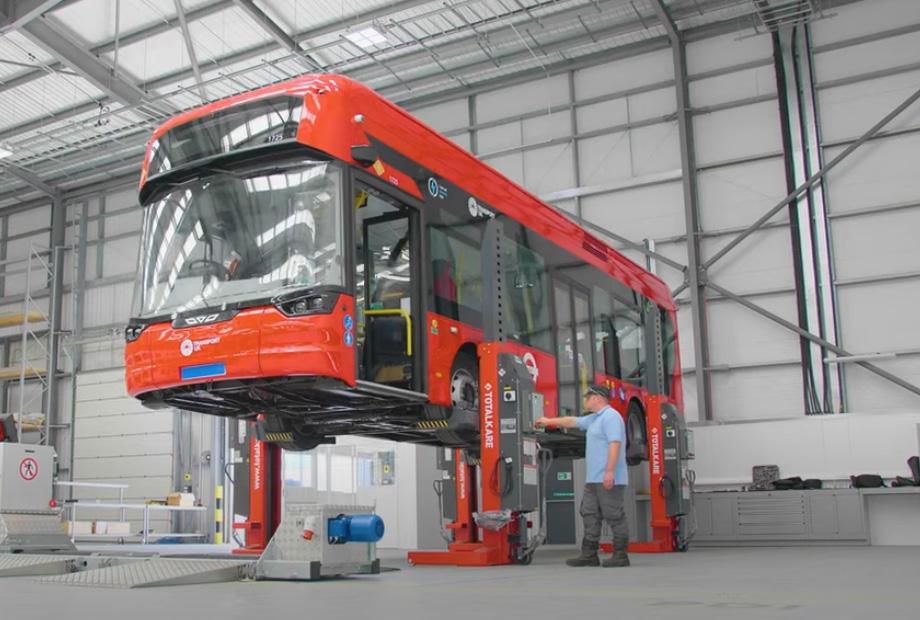
Complementing the mobile column lifts is a mobile brake tester, also supplied by Totalkare. DVSA-approved and capable of testing up to 16,000kg axle load, the brake tester is another highly flexible tool that will help Wrightbus ensure on-road safety and enhance the longevity of vehicles going through the Bicester facility.
With this investment, Wrightbus and Totalkare are set to drive significant advancements in the decarbonisation of public transport, reaffirming their commitment to a cleaner, greener future. Get in touch to find out more www.totalkare.co.uk
sales@totalkare.co.uk 0121 585 2724
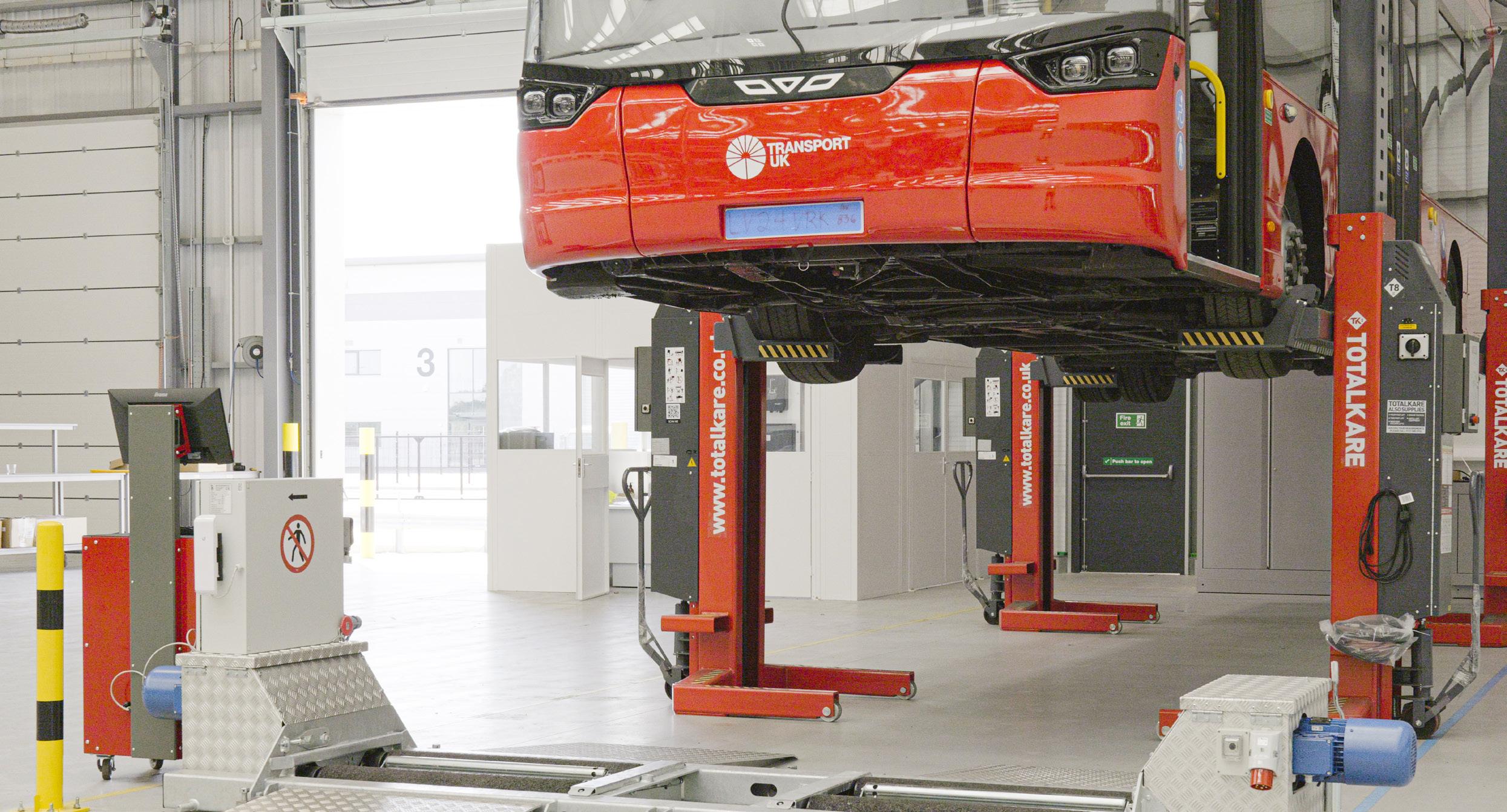
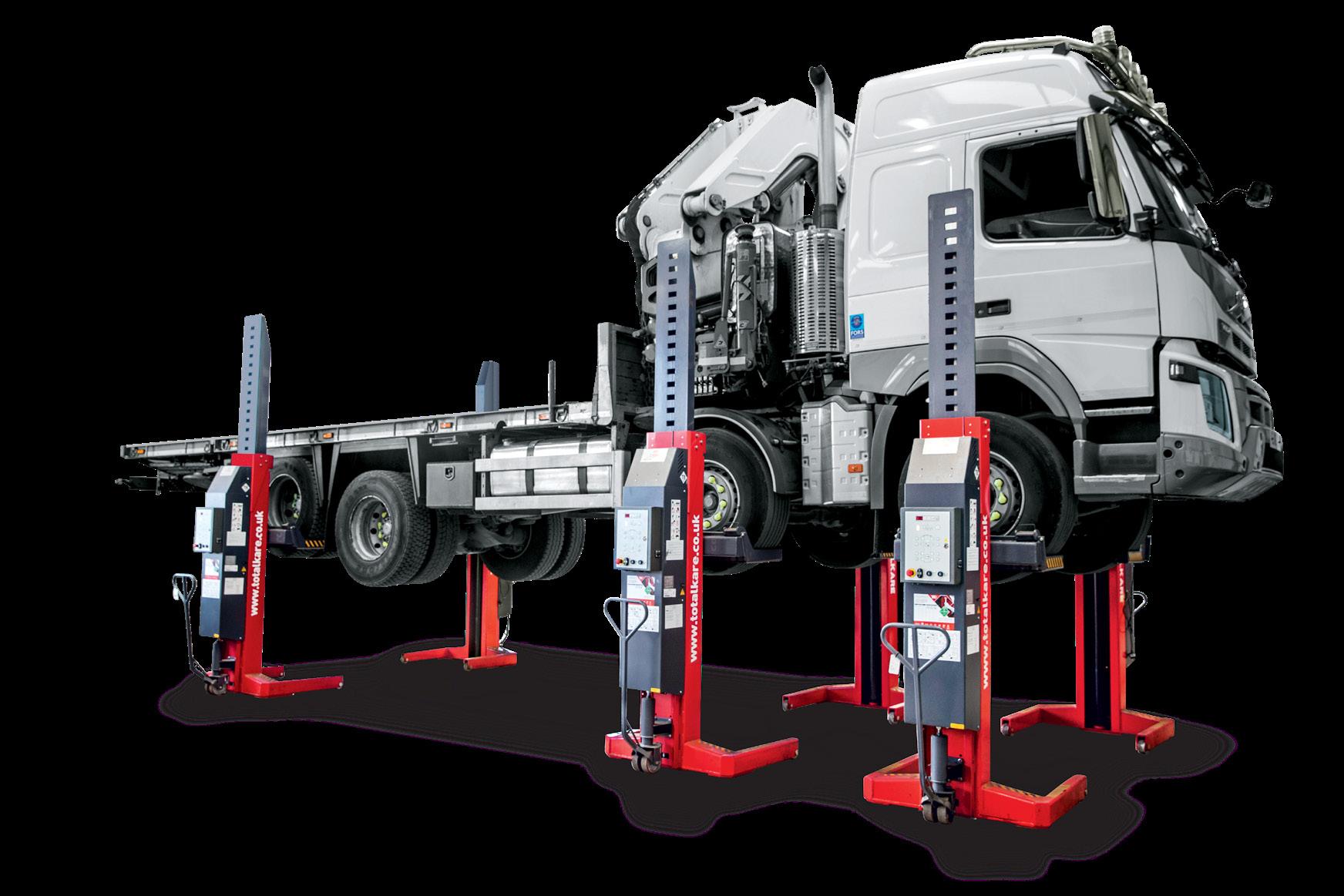




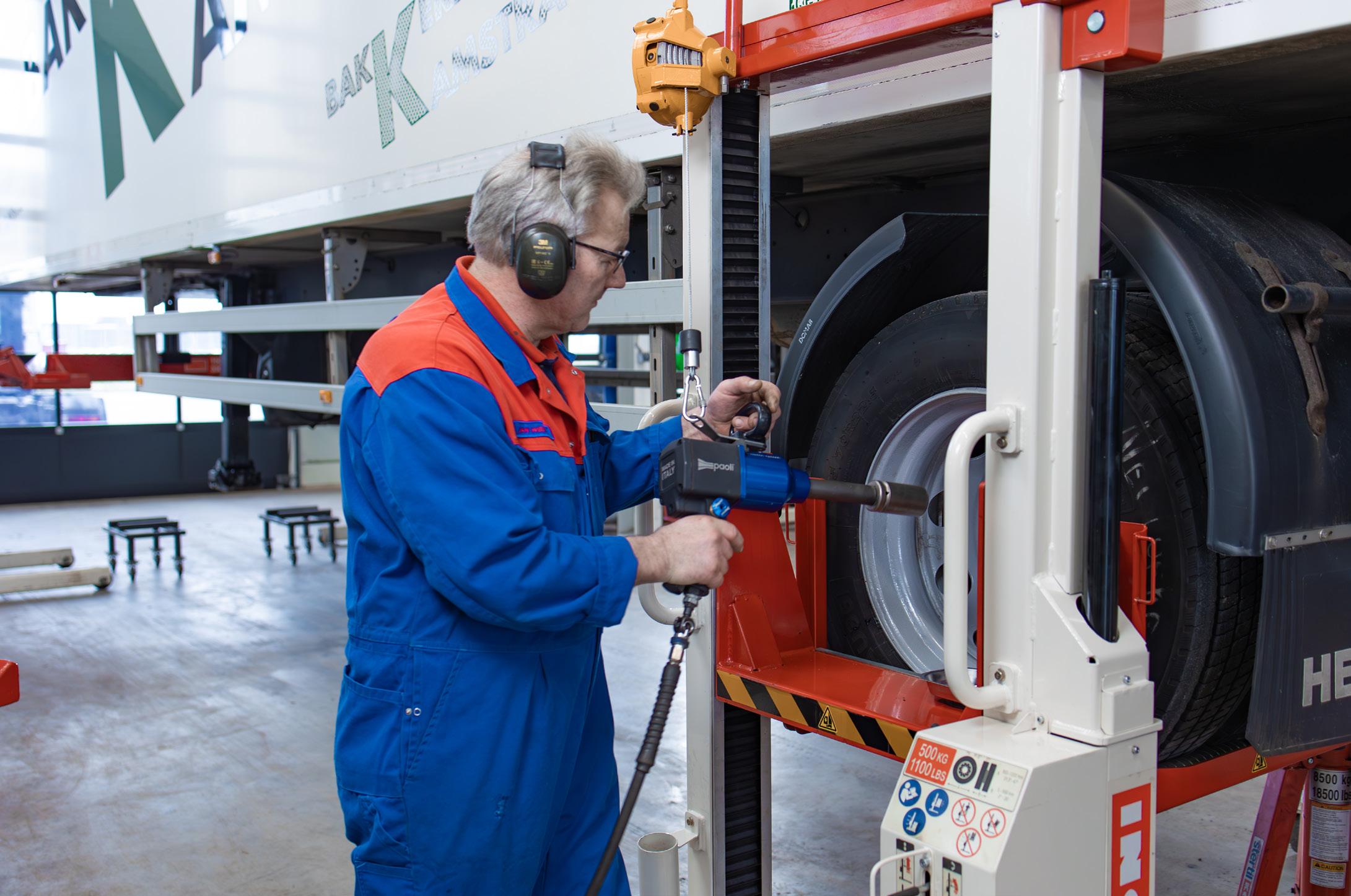
Stertil-Koni, known as the worldwide market leader in heavy duty commercial vehicle lifts, also has a full range of vehicle lifting equipment accessories. For every workshop and in every situation. Recently, the new ergonomic, hydraulic, high lift wheel dolly WD-5P has been introduced.
Spend time working, not waiting. This certainly also applies to workshop mechanics when minimising the difference between the actual time of specific maintenance activities and the desired target time. Whether it concerns periodic or preventive bus maintenance, the goal is to eliminate the downtime of these, often public, transport vehicles.
Dirk-Siemen Wendelaar Bonga, Stertil-Koni’s Global Sales Manager: “With all of our efforts focused on the heavy duty commercial vehicles market and our
patented technology throughout the world,bus fleet workshop managers can be assured that we listen to what they are asking for to make their workshop teams work more ergonomically,safely and efficiently in terms of maintenance,repair and service of the buses.”
In addition to the Stertil-Koni heavy duty vehicle lifts which includes mobile columns, platform lifts, 2- and 4-post lifts, and in-ground lifts, Stertil-Koni manufactures a wide selection of workshop equipment accessories. “Recently,we added a new hydraulic wheel dolly to our assortment which we debuted to the market at the Automechanica in Frankfurt in September 2024.”
Wendelaar Bonga is referring to the Stertil-Koni WD-5P, a fully hydraulic high lift wheel dolly, simplifying the strenuous task of wheel and tyre maintenance.
“The WD-5P high lift wheel dolly is suitable for the removal,transportation and fitting of single,super single and double tyres and wheel combinations from 800 to 1,200 millimetres,and up to 500 kilos.The
open frame construction offers extra working space and accessibility for optimal ergonomic use.Precision alignment is made possible with the hydraulic tilting forks and separate rollers for the first and second wheel.The maximum lifting height is 1,410 millimetres and the tilt angles are 10 degrees up and 4 degrees down.The air-driven hydraulic pump also has adjustable speed control.”
The WD-5P has a retaining bracket for securing the wheels and tyres during removal or transportation. The swivel castor wheels with foot protection are for easy manoeuvrability and positioning, and installed on the top of the wheel dolly frame there is a fully adjustable spring balancer which alleviates heavy physical lifting of the air gun by the mechanic.
Stertil-Koni also has a variety of Axle Stand models, which are available in various heights and capacities: low, mid and high with capacities of 8,500kg and 12,000kg.
Stertil-Koni’s array of vehicle lifting equipment accessories as well as adapters includes to name but a few: transmission jacks; drive-on ramps for low-


clearance buses; floor pit jacks with a top transmission saddle for safe, stable gear box removal, as well as many different types of jacking beams and crossbeams.
A pre-launch of a completely new and unique handheld remote control for the Stertil-Koni in-grounds and specifically for the low rise scissor ECOLIFT will shortly be available.
“Our new workshop equipment accessories were enthusiastically received as they contribute to an effective and safe working environment for mechanics worldwide”, states Wendelaar Bonga. “The handheld remote control has initially been developed for our inground vehicle lifts,to easily position the lifting units and to give the mechanic complete visibility during lifting also without the inconvenience of being wired. Safe,effective and it optimises the positioning and lifting process without tripping hazard,above head cable systems,no expensive suspension rail for heavy wired remote controls,which also usually require two hands to hold.”
“Operation with the handheld remote control is easy and very intuitive,” Wendelaar Bonga continues.
“Mechanics are taken through the operating process on the remote’s colour screen.To enhance visibility there is also a built-in LED light which can be used for dark spaces when working on the vehicles.”

Ergonomic wheel and tyre maintenance with the Stertil-Koni’s High Lift Wheel Dolly,the WD-5P

The remote control is conveniently magnetic and can easily be stowed away on the control box on or on any metal surface when not in use. And all in the name of safety… in accordance with CE and UKCA and other international safety requirements, it is equipped with an emergency stop.
Stertil-Koni has a dedicated R&D department for vehicle lifting solutions providing customer-focused product developments. “Stertil-Koni makes a difference by focusing on heavy duty vehicles and working with customers and turning customer requirements into value-added inspection,maintenance and repair equipment.”
For information about our heavy duty vehicle lifting solutions, please contact us:
www.stertilkoni.com
vehiclelifts@stertil.nl
+31 512 33 44 44


Municipal transport companies are increasingly using the new heightadjustable roof working platforms.
Columbus McKinnon serves the market with its special lifting solutions from their Pfaff-silberblau and STAHL CraneSystems brands. Especially regarding buses the implemented solution is used to safely and efficiently carry out maintenance and repair work on the roofs and windows of buses. Columbus McKinnon has already
Thanks to the flexible modular concept with adjustable heights and different segment lengths, the roof-working platforms can be adapted quickly and flexibly to all buses. The electromechanically extendable working platforms and sliding safety guards at the front and rear ensure ergonomic allround fall protection, regardless of which fleet vehicle
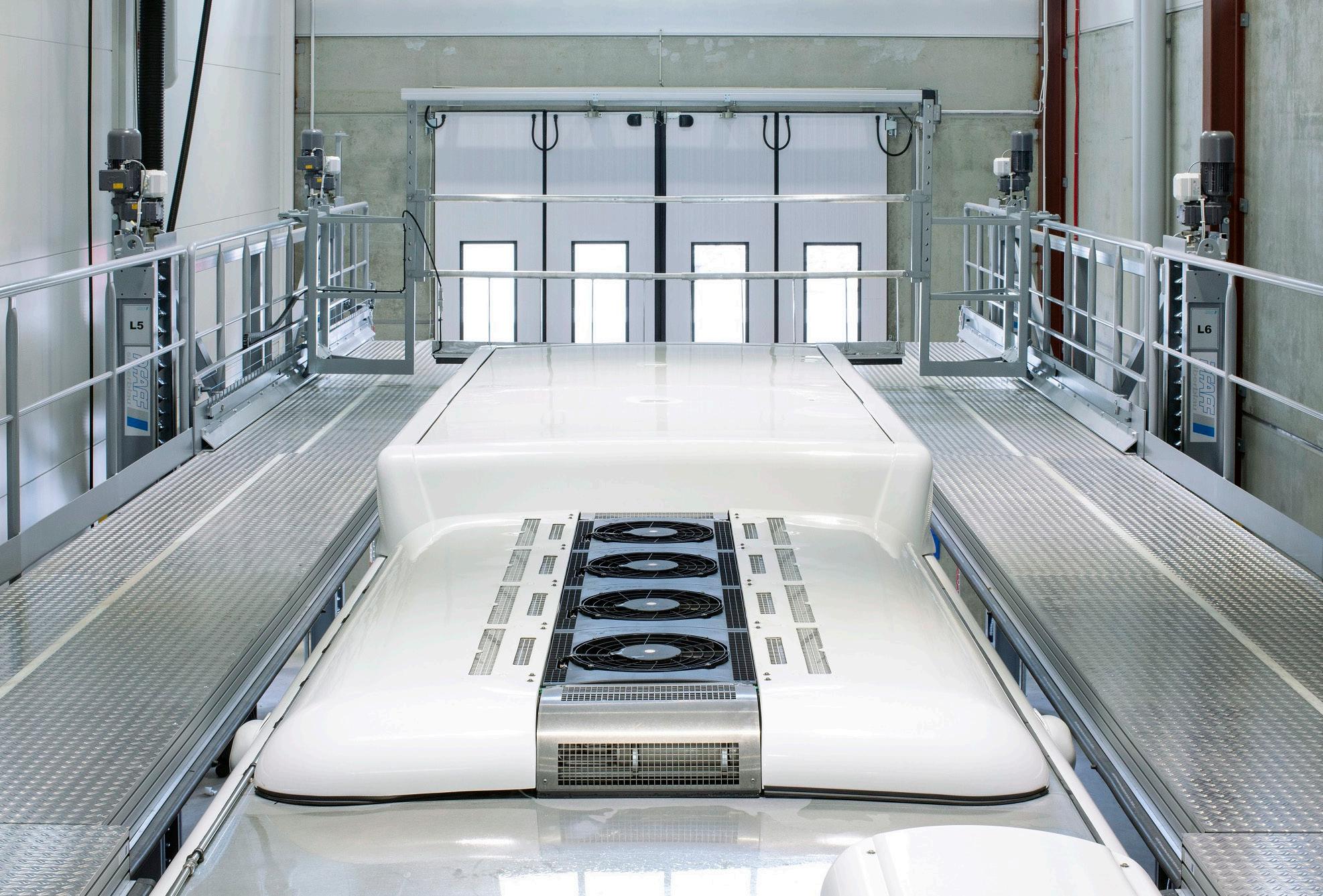
Roof-working platforms provide a safe working area and give the mechanics access to the battery system of e-buses
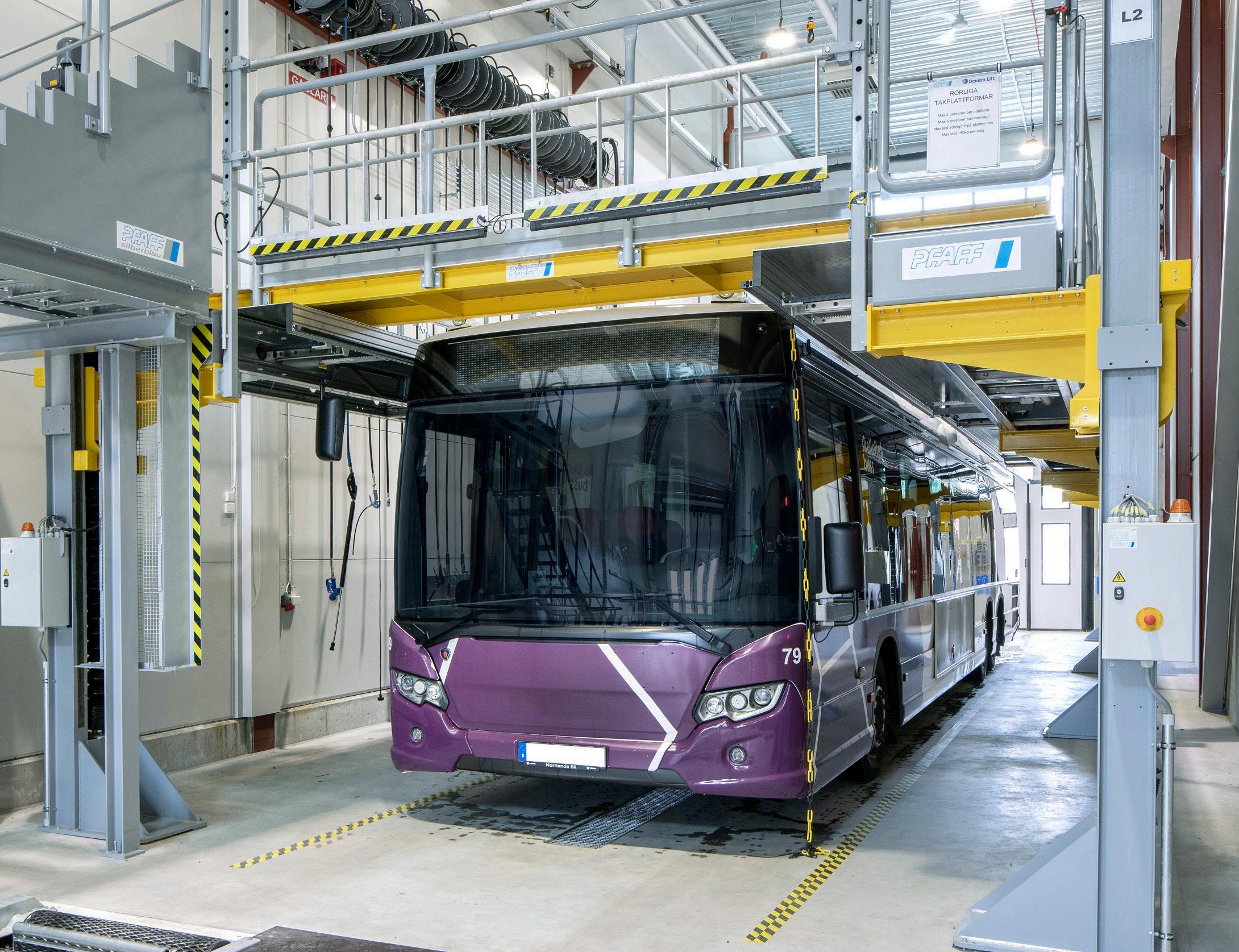
their workplace on the roof of the vehicle via heightadjustable stairs. Optional components such as various crane systems, lighting equipment, signalling systems or monitored access doors increase efficiency and safety.
Nowadays more and more buses are battery-powered. This kind of articulated electric bus has ten powerful high-voltage battery packs with a total capacity of 330kWh, which ensure an appropriate range. In contrast to conventional buses, which run on diesel and require hardly any work on the roof, electric buses require more maintenance work on the roof, because heavy electrical and other high-maintenance components, such as battery packs as well as fuse boxes, inverters and air conditioning systems, are located there for
the sake of convenience. These components require regular maintenance. There are also additional hazards and challenges for the maintenance crew due to the rounded plastic roofs.
The entire system can be supplied as a turnkey solution with the roof-working platform from Pfaff-silberblau and an integrated ST electric chain hoist from STAHL CraneSystems. The ST chain hoist range from this
With these kinds of solutions, municipal bus operators can ensure safe working conditions even with mixed vehicle fleets. The flexibly adaptable roof-working platforms set high safety standards, by minimising hazardous areas where people could fall and providing ergonomic access to the vehicle roof.
manufacturer is regarded by users as powerful, reliable and undemanding in terms of maintenance and energy consumption. The ST modular system allows numerous combinations of the sub-assemblies for customised solutions and adjustment heights in the load capacity range from 125kg to 6,300kg. With the hoist, loads such as batteries or other heavy components can be conveniently and ergonomically replaced on the roof of the vehicles.
Columbus McKinnon’s service package ranges from the planning of the working platform to the commissioning and training of the personnel.
Installation in new buildings and existing halls is preceded by comprehensive consultation and analysis of the current infrastructure. The company also offers a comprehensive after-sales service, including long-term maintenance contracts and a spare parts service.
With these kinds of solutions, municipal bus operators can ensure safe working conditions even with mixed vehicle fleets. The flexibly adaptable roof-working platforms set high safety standards, by minimising hazardous areas where people could fall and providing ergonomic access to the vehicle roof. They provide fleet operators with modern, safe and reliable mobility. Due to short set-up times, the vehicles are quickly ready for operation again, and their operating times in transport use are extended.
For more information visit our website or contact one of the team.

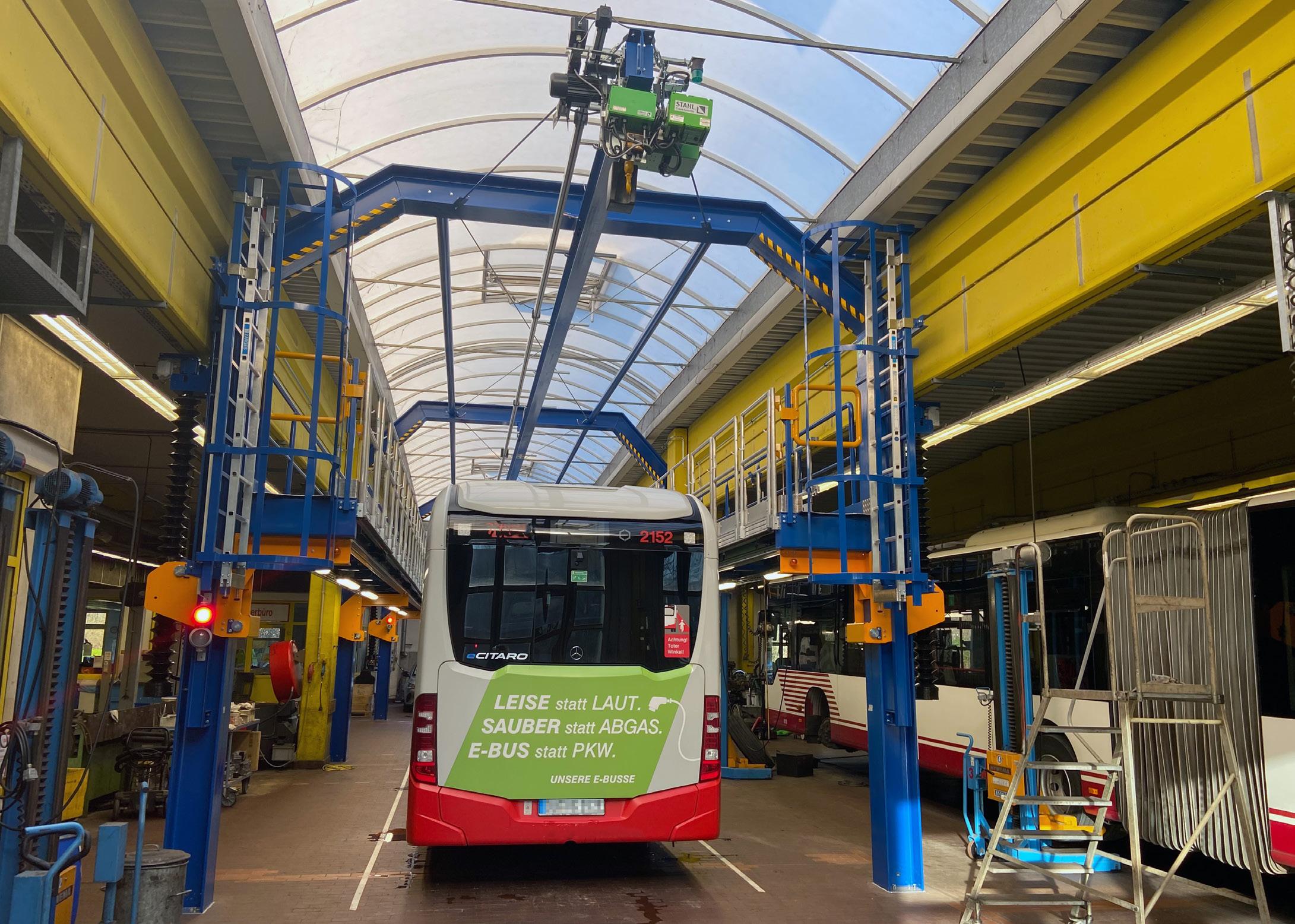

Tenix p.42
Driving the UK’s Decarbonisation Through Electrification of Public Transport

Stroco ApS p.45
Stroco Launches New Heater to Meet Specific Needs of Electric Buses
Moltec International p.48
Quality Engineered Solutions


Inthe UK, public transport plays a key role in reducing carbon emissions. According to research by the Department for Transport, taking the bus instead of driving can reduce an individual's carbon emissions by up to 55% per journey.
Additionally, a full double-decker bus can take as many as 75 cars off the road, significantly lowering congestion and emissions. If more people used public transport regularly, it’s estimated that the UK could save up to 2 million tonnes of CO2 annually, making it a vital solution for achieving net-zero goals.
The UK is advancing toward a zero-emission future in public transport, driven by the ‘Bus Back Better’ initiative, which promotes electrification to meet
decarbonisation goals. As of August 2024, London has over 1,800 of its near 9,000 buses operating as battery electric vehicles, marking significant progress in the transition.
However, the electrification journey is still in its formative stages, with plenty of challenges and opportunities ahead. As the demand for reliable fleet management and charging solutions rises, companies from around the world, particularly the Nordics, are stepping in to offer their expertise.
The UK can learn valuable lessons from the Nordic region, which has pioneered electric bus operations
in diverse weather conditions over many years. A key takeaway from their experience is that running an electric fleet successfully requires comprehensive data management and smart systems. Without these, the transition from diesel to electricity can lead to operational inefficiencies and increased costs.
In many cases, bus operators across Europe, including the UK, rely on proprietary systems provided by vehicle or charger manufacturers. However, this approach often leads to a lack of flexibility. Companies typically operate multi-brand vehicle fleets and use chargers from various manufacturers, which can result in incompatibility issues and inefficiencies. To avoid being locked into a single supplier’s ecosystem, independent and brand-agnostic solutions are essential for effective fleet management and electrification.
One company making significant contributions to this shift toward sustainable public transport is Tenix. Founded in Bergen, Norway, in 2012, Tenix offers a range of solutions designed to improve the efficiency and cost-effectiveness of electric bus operations. Their systems are designed not only to replace fragmented management tools but also to enhance the overall environmental impact of transport operations.
Tenix’s key offerings include:
Tenix Charge: As a cloud-based charging management platform, Tenix Charge supports 15+ brands of vehicles and 30+ chargers, making it ideal for operators with diverse fleets. It integrates seamlessly with other fleet management systems, optimising charging sessions based on electricity prices from sources like Nordpool. This leads to predictable and cost-effective charging,
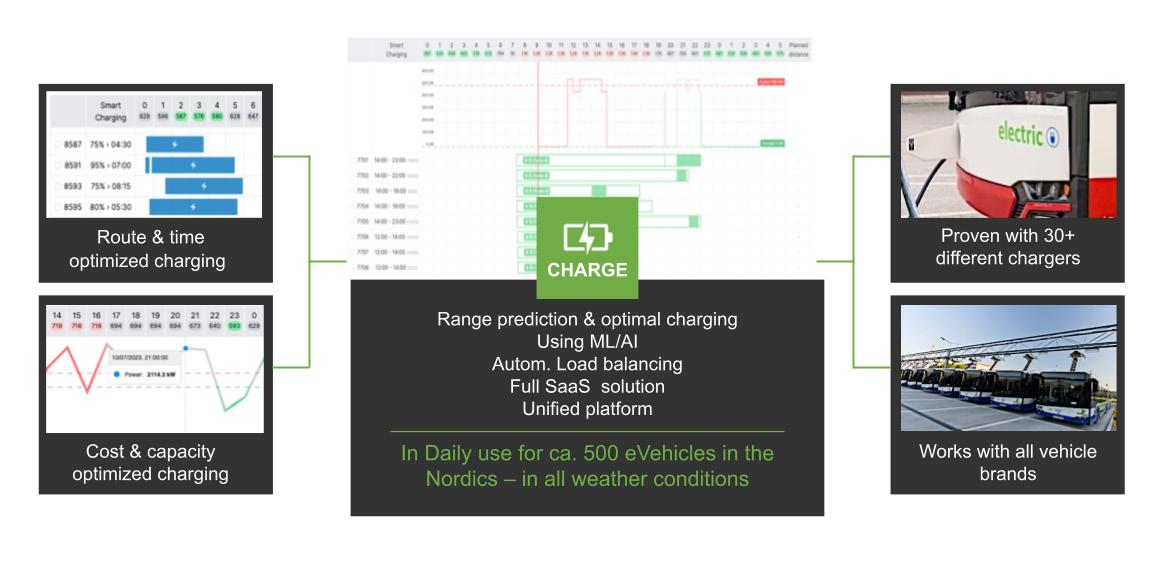
helping operators adhere to their schedules while minimising costs.
Charge uses machine learning MLP (Multilayer Perceptron) with 30+ data parameters such as temperature, capacity, tyre pressure, route topology, speed and weight to predict optimal state of charge (SoC) percentage for a specific route by day.
Tenix Fleet: This system provides detailed vehicle data that helps operators monitor and optimise fleet performance. It offers insights such as battery health predictions, temperature and tyre measurements, and real-time tracking of driving patterns, all of which help reduce operational risks and improve efficiency. The ‘Eco Drive’ module ensures optimal driver performance with a 10–15% reduction in cost observed.
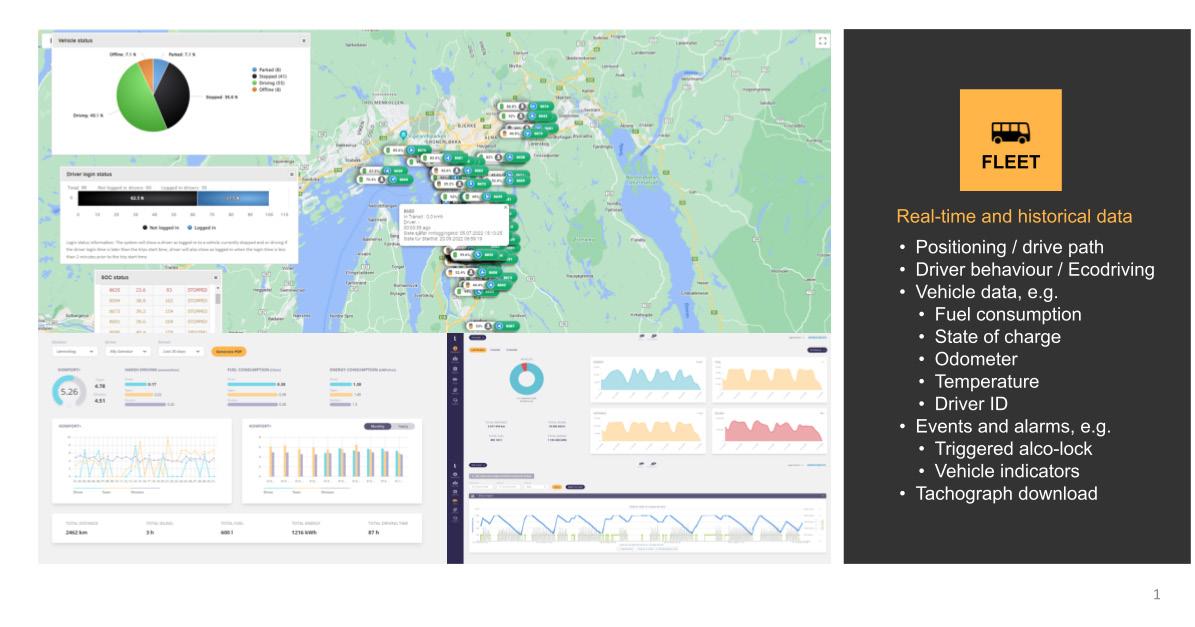
Optimal operations with Tenix Fleet
Tenix Maintenance: To ensure electric buses remain operationally efficient, Tenix offers a proactive maintenance system. This tool allows operators to prioritise and report maintenance issues based on real-time data from the fleet, reducing downtime and preventing larger, more costly repairs down the line.
Over the past year, Tenix has driven significant operational and financial gains for its customers, reducing depot investment by 20–25% and energy costs by 10–15%. These advancements are underpinned by its commitment to delivering safe and efficient operations, where streamlined performance means a reduced requirement for vehicle fleet numbers.
Furthermore, in January 2024 amid Oslo’s heavy snowfall, Tenix demonstrated exceptional performance, showcasing the transformative capabilities of the platform and its Charge functionality. According to a leading operator, its advanced charging management
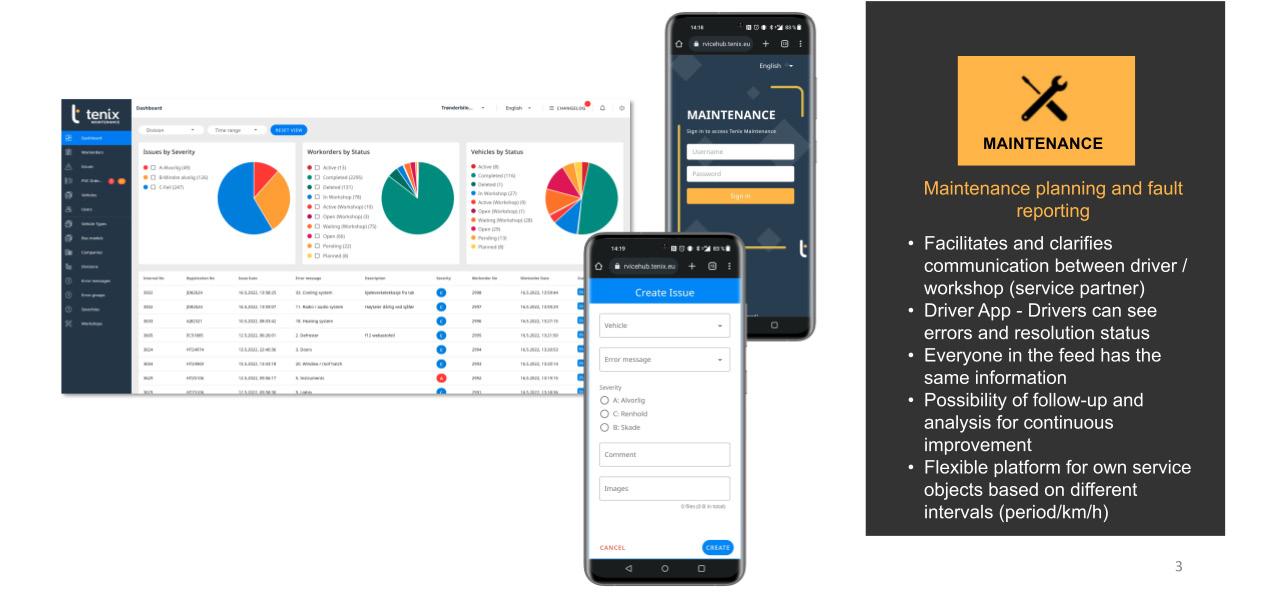
features ensured over 90% punctuality, even in challenging conditions – setting a new standard for operational efficiency.
Tenix’s presence in the UK and Europe is growing rapidly, driven by a combination of advanced technology and successful partnerships. In Norway, Tenix has partnered with major transport operators like Vy Buss and Tide, managing over 4,000 buses and trucks with its systems. This success has led to an order book of more than NOK 50 million.
Norway is globally recognized for its leadership in bus electrification, and other countries are following suit. Tenix is well-positioned to support this transition, with offices in Norway, Sweden, the Netherlands, and more recently, the UK.
To drive further expansion in the UK, Tenix has appointed David Rooney as the Sales Director for the UK and Ireland. With over 20 years of experience
in the bus industry, his appointment underscores Tenix’s commitment to helping the UK reach its decarbonisation goals. David brings a wealth of experience from his previous roles at First Bus and National Express.
As the UK accelerates towards its zero-emission target, the role of intelligent fleet management and charging systems will become ever more critical. Companies like Tenix, with proven experience in electrification from the Nordics, will be instrumental in helping the UK navigate the operational complexities of this transformation.
With the right systems in place, bus operators can look forward to not only reducing emissions but also improving the cost-effectiveness and reliability of their fleets. The journey to a sustainable public transport system may be challenging, but with the help of innovative solutions, it is undoubtedly achievable.
For more information contact David Rooney, UK Sales Director, Tenix
david.rooney@tenix.eu
+44 (0)7796 253959 www.tenix.eu
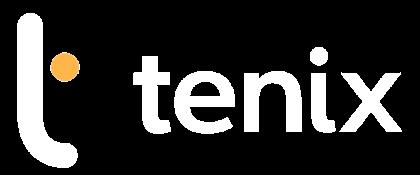
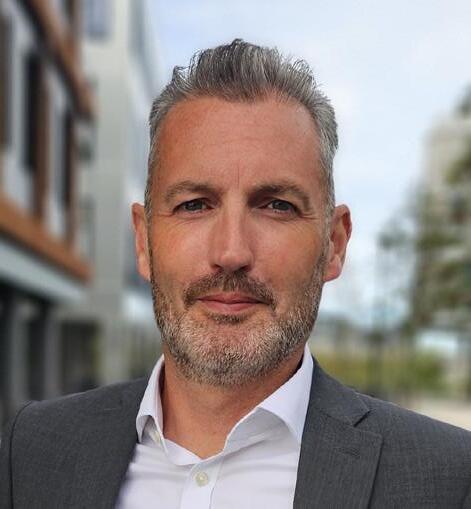
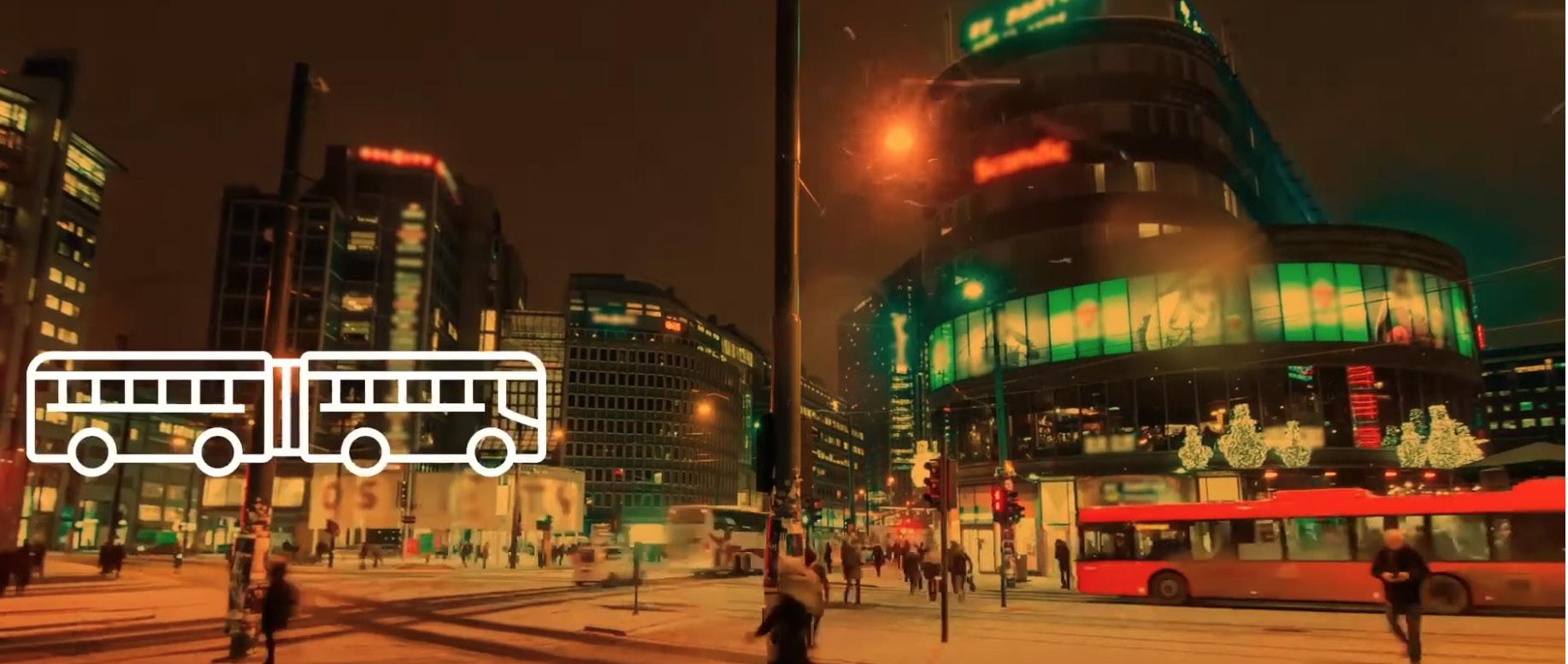




The days of traditional bus heaters are numbered, says Stroco A/S International Sales Manager Søren Rasmussen, who points to a shift in requirements driven by the growing adoption of electric buses.
The heating needs of electric buses differ substantially from their diesel-powered predecessors, particularly in terms of how much heating is required, says Søren Rasmussen, International Sales Manager at Stroco A/S.
Electric buses need less heating, primarily due to their energy efficiency in comparison to older diesel buses,
which rely on waste heat from the combustion engine. This is not only less efficient but also inconsistent, particularly when the vehicle is idling or travelling at low speeds.
Electric buses are often equipped with advanced thermal management systems and employ heating technologies like heat pumps, which work efficiently above 7°C (45°F). However, in regions with harsh winters, like Northern Europe, relying solely on heat pumps significantly reduces an electric bus's range due to increased power consumption.
For these challenging environments, specialised
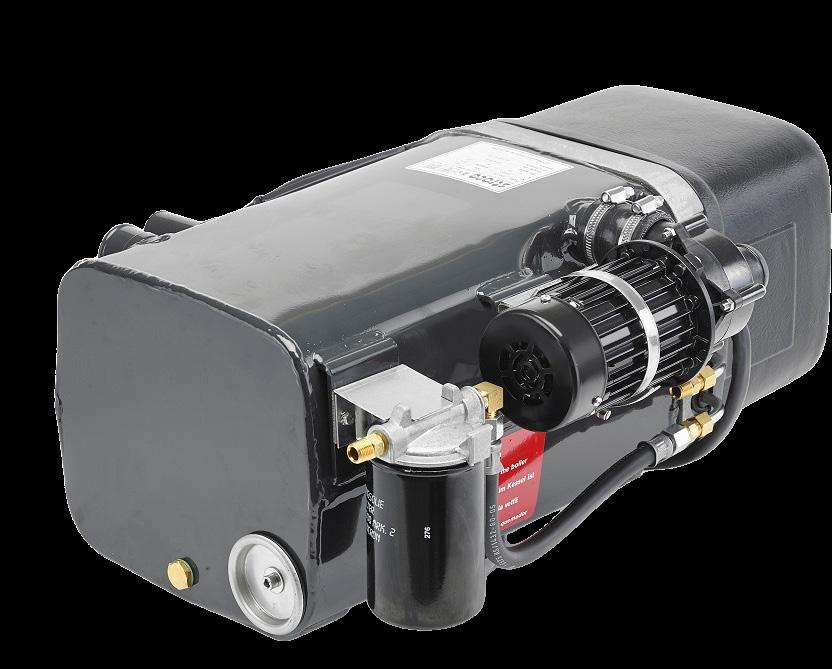

heating solutions that don't rely on the bus's main battery, such as those offered by Stroco, are crucial. These combustion-based heating systems maintain passenger comfort without compromising the bus's electric range, ensuring consistent performance even in cold weather conditions.
Stroco A/S has been in the transport heating market for over 50 years, and offers a wide range of heating solutions, which are known for their high efficiency and minimal maintenance.
A leader in the electric bus heating market has been the company’s 35.02 M – LE (low emission) Hybrid heater, which was the industry’s first combined fuelburning heater/electrically charged boiler.
This model is able to run on diesel and alternative fuels such as hydrotreated vegetable oil (HVO) and rapeseed methyl ester (RME), which when used enables the vehicle to run 100% fossil free.
Stroco is the only company that manufactures heaters that can see HVO’s blue flame, thanks to the photocell it uses.
“When you use HVO or biodiesel the flame goes blue and this can be an issue because if that blue flame isn’t recognised,then the combustion heater will not work. This is an issue for many heater manufacturers,but not us.We developed a special photocell for our heaters
that enables us to reliably register the flame every time,” Rasmussen explains.
To date, happy customers have purchased more than 1,000 units, but behind the scenes Stroco A/S engineers have been hard at work developing a new, advanced model.
Stroco A/S is always looking to advance its offerings, and for the last year experts at the company have been working hard to try and find ways to improve on its successful 35kW model. This has led to the development of the Stroco 23kW LE Hybrid heater, which has all the capabilities of its predecessor, but uses less energy.
“This was developed because we saw that normal 30kW heaters were producing more heat than was necessary in some cases,which meant lots of stops and starts. This created unnecessary amounts of soot and used up more fuel,so we looked to develop a better solution for these situations,” Rasmussen says.
From the outside, Stroco’s new 23kW model looks the same as the old 35.2kW, as it has the same dimensions. Where you’ll find the difference is inside the heater.
Stroco engineers developed a new low-emission (LE) combustion unit and put a smaller nuzzle into this
heater. The nozzle is fitted with a non-return valve which ensures that the remaining fuel in the nozzle and nozzle holder isn’t accidentally released into the combustion chamber. This means that the heater doesn’t stop and start as often as the older model, and the heater doesn’t give off as much smoke when it does.
Rasmussen highlights the benefits of the new 23kW LE Hybrid heater.
“All in all, this new model offers a smoother ride, less noise and a better fuel economy thanks to a 10% reduction in fuel used.
“If a 30kW oil boiler uses three litres per hour and a 23kW uses 2.7,that’s a saving of 0.3 litres of fuel per hour,” he continues. “If one litre of fuel costs DKK 10 for example,then the saving is DKK 1 per hour.If the heater runs for five hours,that’s a saving of DKK 5 per day,per bus.So,if an operator runs services 30 days a month,
“In the Nordics,the size of an operator’s electric bus fleet can vary significantly,but on average small to medium cities will likely have fleets of 20–50 vehicles, while fleets in larger cities and urban areas can range from 100–300 buses.Multiply these savings by fleet size and you can see the dramatic fuel – and therefore cost – savings this new model offers.”
Since its soft launch earlier this year, Stroco has already sold more than 200 23kW heater units, and the company plans to officially launch this model at Persontrafik 2024 in Gothenburg this November.
Stroco will be joining its Swedish dealer TK Bussklimat AB at the event, but for those that cannot attend in person, you can learn more about Stroco’s heaters by visiting www.stroco.dk or contacting Søren Rasmussen
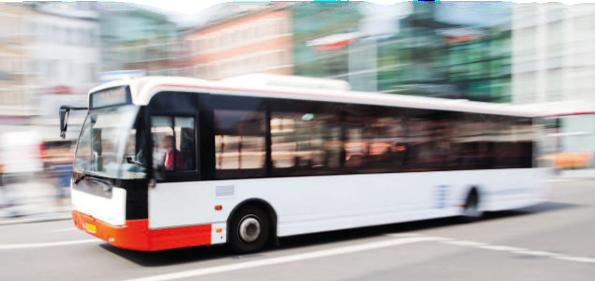
Heaters:
Runs on diesel, biodiesel, HVO, RME and ethanol
Can be equipped for electric night operation
Can be equipped with LE-function
Electricity:
Fossil-free heating in electric buses
Up to 4 heating elements
From 7.5kW to 60kW
From 400VDC to 727VDC
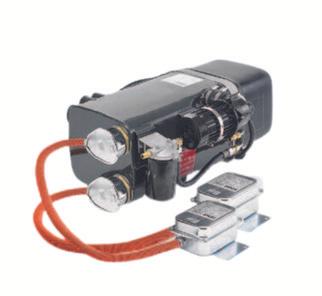
for electric buses environment-friendly combi heater Specially developed for hybrid and electric buses
100% fossil free when using HVO






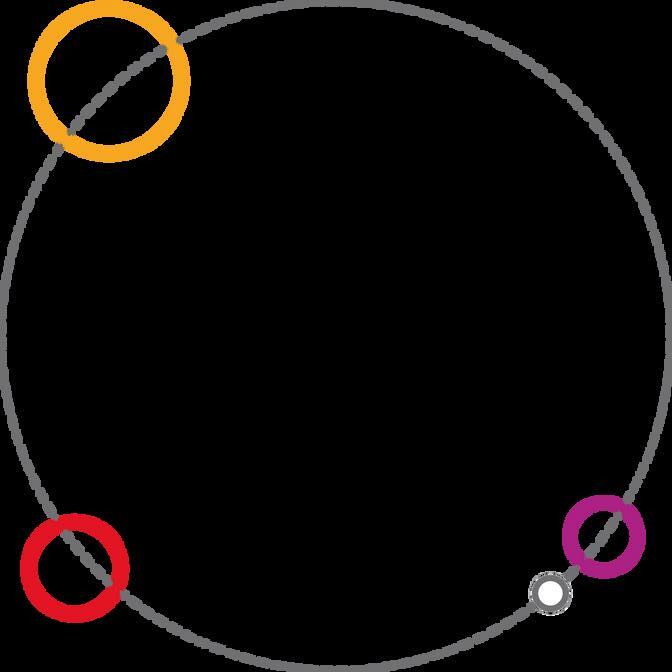


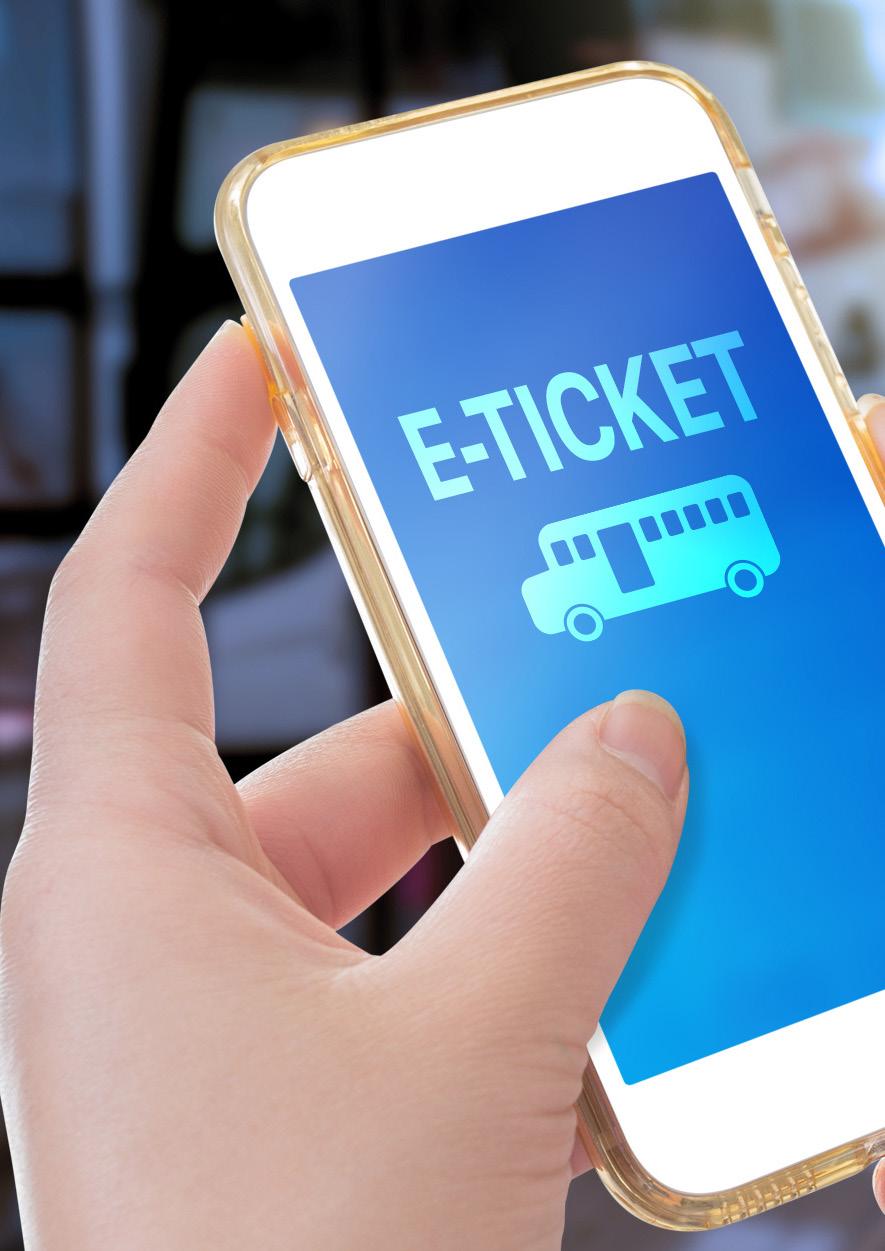

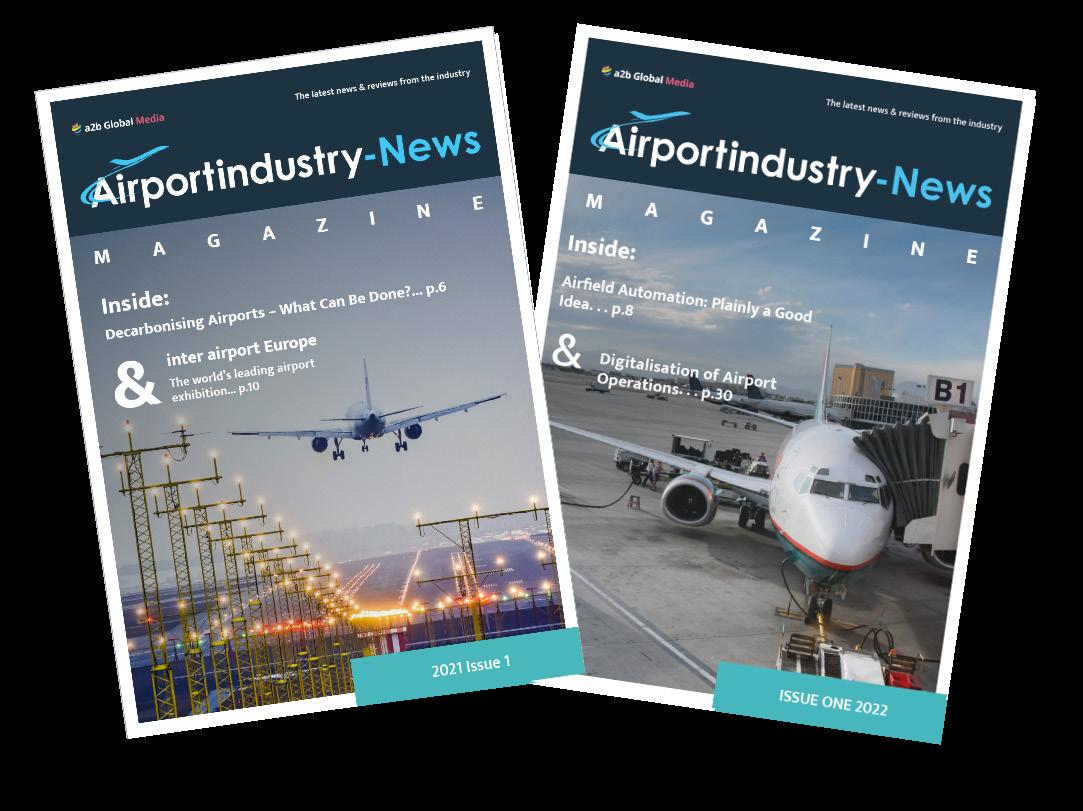

By Miki Szikszai, CEO and Founder of Snapper Services
Acollaborative, feedback-rich environment in any business can ignite innovation and creative problem-solving, fostering a culture of continuous improvement and driving performance to new heights.
This applies to intelligent transport solution (ITS) providers too. Collaboration between stakeholders and transit managers is crucial to maximising output and developing systems that not only meet but exceed the needs of operators and authorities.
At Snapper Services we recognise the value of working together and embracing feedback to drive progress. Our Mosaiq Transit Intelligence Suite, launched last year, is designed to enhance public transit experiences through data analytics. Since its introduction, we've been actively engaging with Mosaiq Insights users to refine and expand the suite based on their valuable input.
When developing transit solutions, it can be easy to work in isolation, treating each product as a standalone solution. We are working hard to break away from this approach by creating a system that integrates seamlessly with other platforms, which is critical to embracing a collaborative spirit.
We’ve designed an off-the-shelf product that enhances and integrates with existing technologies, aiming to transform the transit sector through shared data and collective feedback.


As a leader in transit technology, we focus on understanding how our system works for our partners and customers. We have been working closely with Tower Transit, which operates the Liberty Bus Network in Jersey. Tower Transit has had access to Mosaiq Insights since early 2024.
Sam Greaves, the organisation’s Commercial Manager, with nearly 30 years of experience in the transit sector, has been sharing his feedback since the start. "Data insights are fundamental to understanding the evolving needs of transit users.They help us anticipate trends, optimise services and make informed decisions that
“The Mosaiq team is very good with data,they understand bus data and the real insights needed to improve bus operations,which is really valuable.”
Sam Greaves, Commercial Manager, Liberty Bus
drive efficiency.But ultimately,our mission is to create an exceptional experience for passengers.They are at the heart of everything we do,” he said.
Fostering improvement with open dialogue and shared goals can create a meaningful, real-world impact. Our user experience (UX) team works with customers and industry experts like Sam to uncover key challenges and make it more impactful while evolving to meet the broader needs of the industry. “What has been great for me is knowing that the conversations I’m having with the team are making a difference.I’m involved in the development process and my insights are valued, which is incredibly motivating,” he said.
Feedback is essential for ensuring ITS and data solutions can effectively address the needs of public transit professionals. “I’m almost as proud of what that team is doing with this system as they are,” he said.
Nick Parfene, Snapper Services Chief Technology Officer explains: “The development and UX teams actively seek and reflect on all feedback received to understand the challenges operators and authorities face.This insight helps us tailor Mosaiq Insights to address these challenges effectively on a broader scale and evaluate where we can have the most impact.”
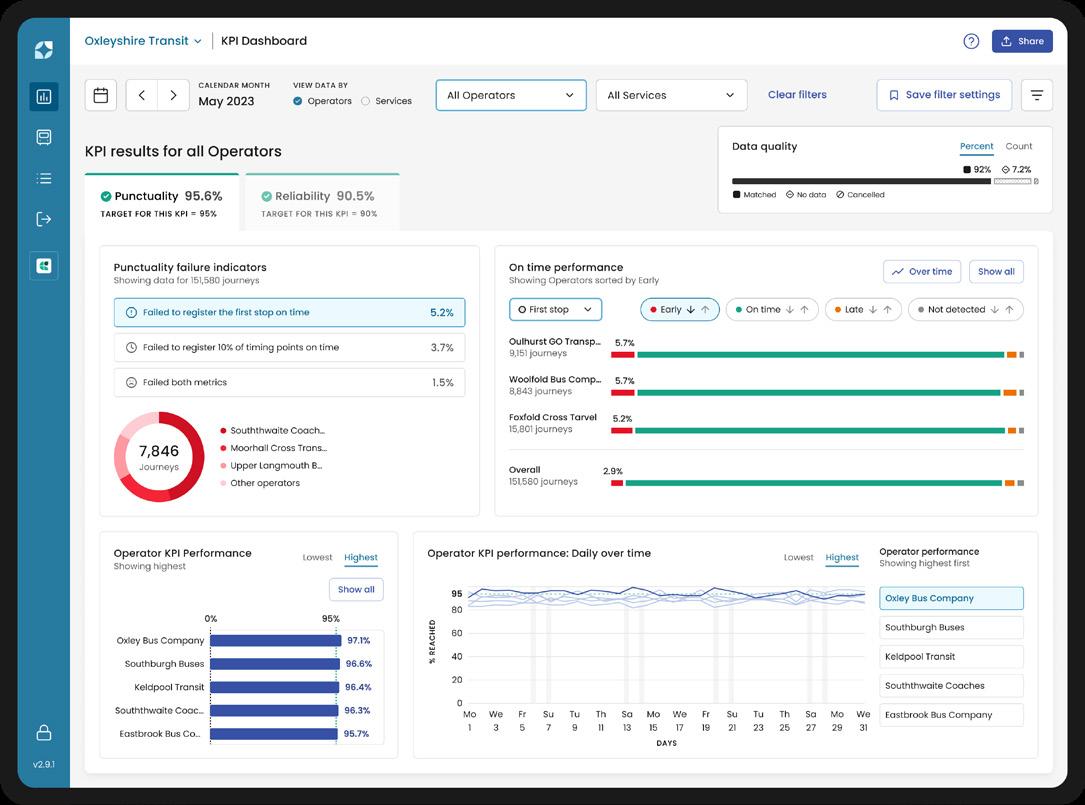
Sam’s feedback has been instrumental in guiding the development of Mosaiq Insights. We continuously refine the system to meet the evolving needs of the transit industry, maintaining a user-centred design at the core of our process. Our UX team uses various research techniques to understand the unique needs of the sector, ensuring our solutions drive effective outcomes.
Speaking with end-users like Sam helps address critical challenges. Snapper Services Head of UX, Richard Nichol explains: “We are committed to delivering an outstanding UX by focusing on real,validated user needs,ensuring our solutions seamlessly integrate into existing workflows and drive meaningful improvements across bus operations and public transit."
This commitment ensures that every aspect of Mosaiq Insights is meticulously designed to enhance the user experience. We apply our deep understanding to produce intuitive interfaces and seamless interactions that elevate productivity and ease of use.
Sam adds: “The Mosaiq team is very good with data, they understand bus data and the real insights needed to improve bus operations,which is really valuable.”
As more transit operators and authorities embrace data solutions to improve service delivery, fostering a culture of collaboration among all stakeholders will be essential. At Snapper Services, we are dedicated to working closely with our customers and partners to drive the transit industry towards a smarter, more connected future.
For more information contact us:
www.mosaiq.co +44 7867 906374
jon.salmon@snapper.co.nz

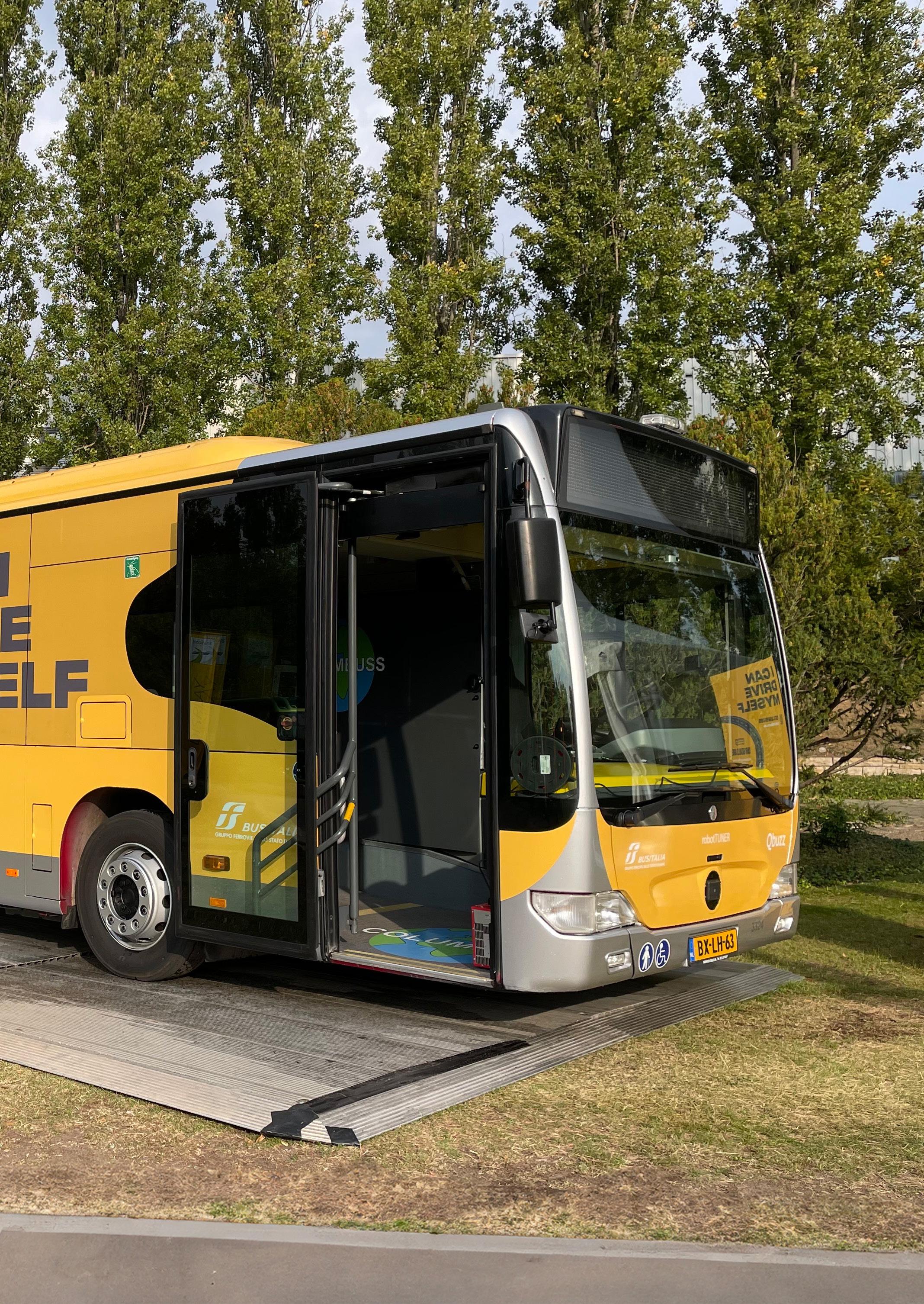
Thank you for reading Issue Two 2024 of the Bus-News magazine. Visit our website to keep up to date with the bus sector.